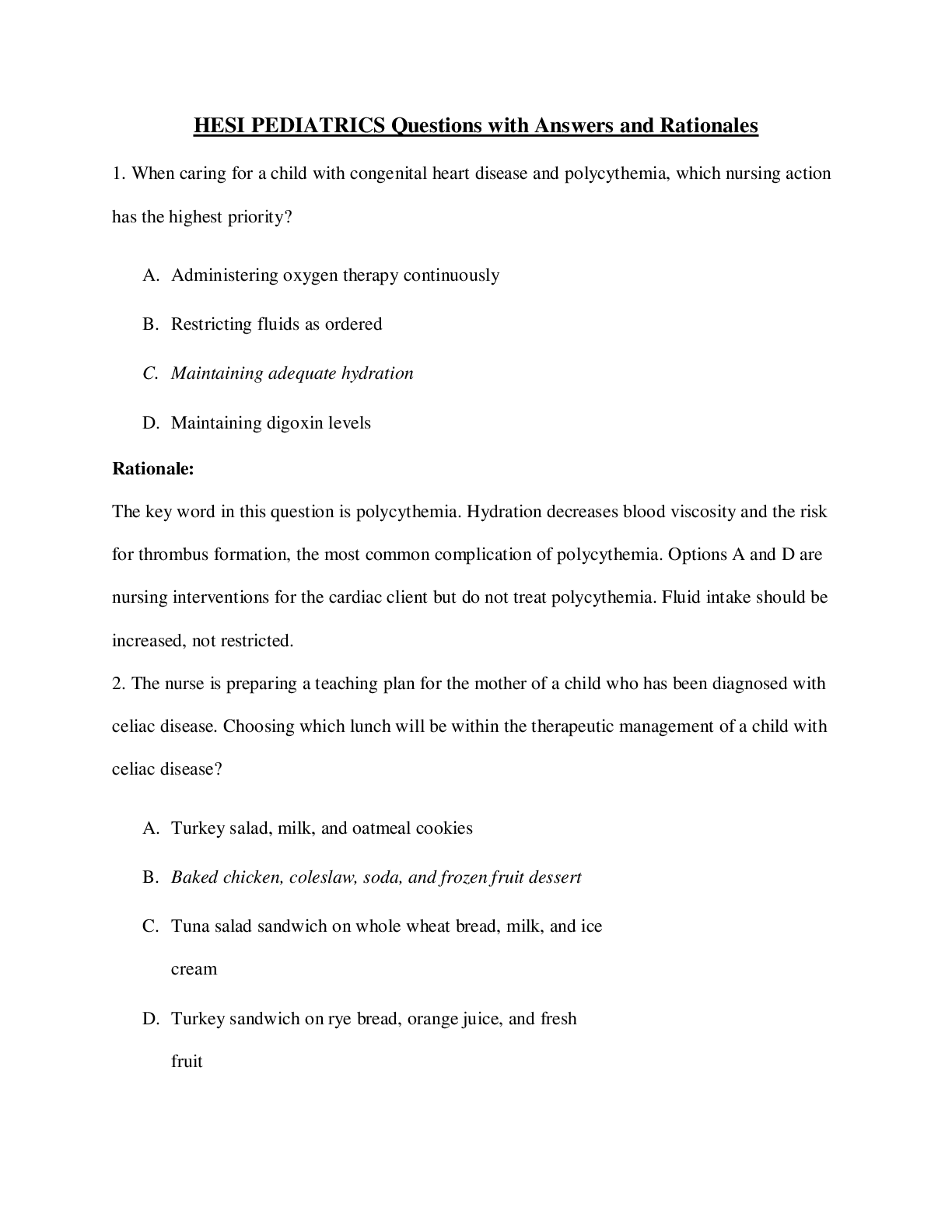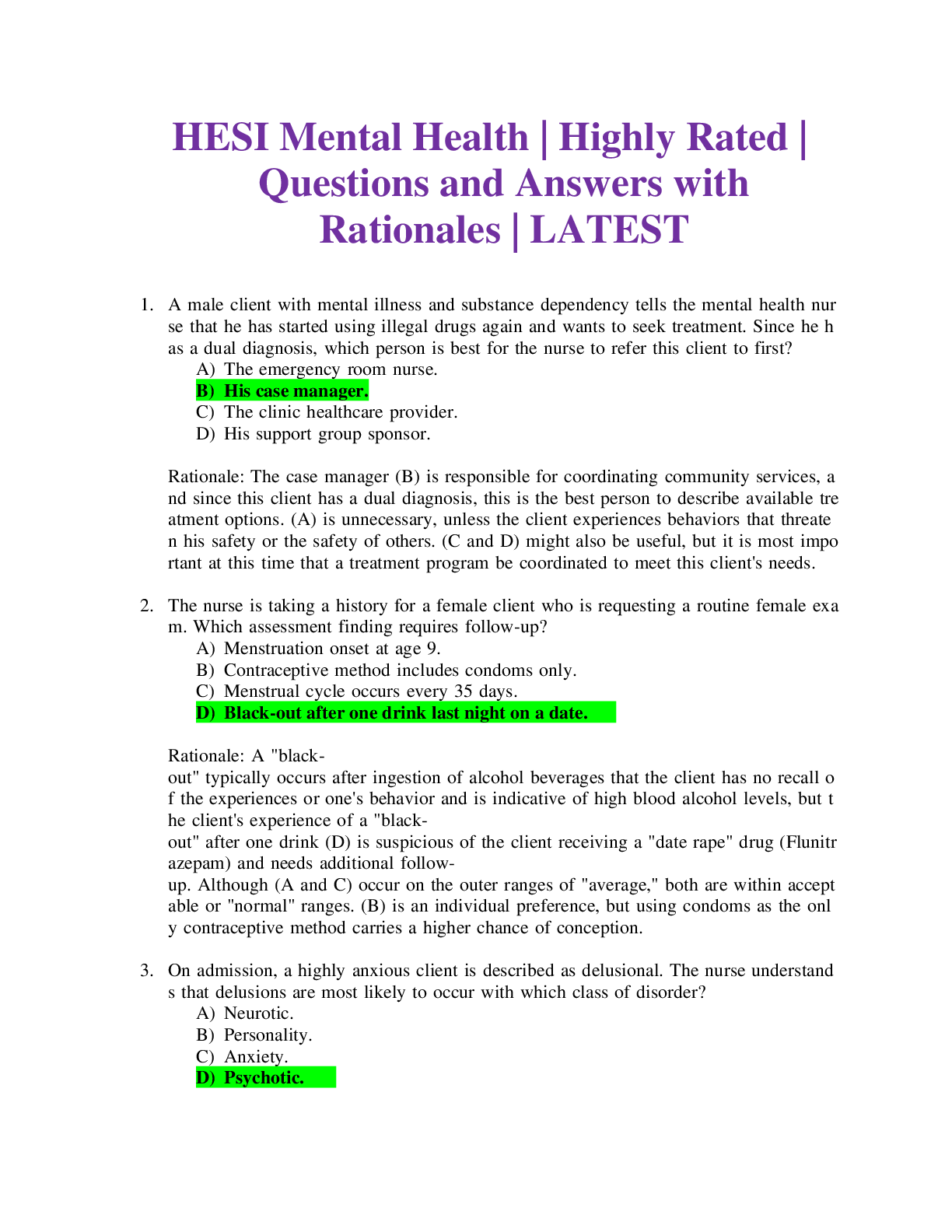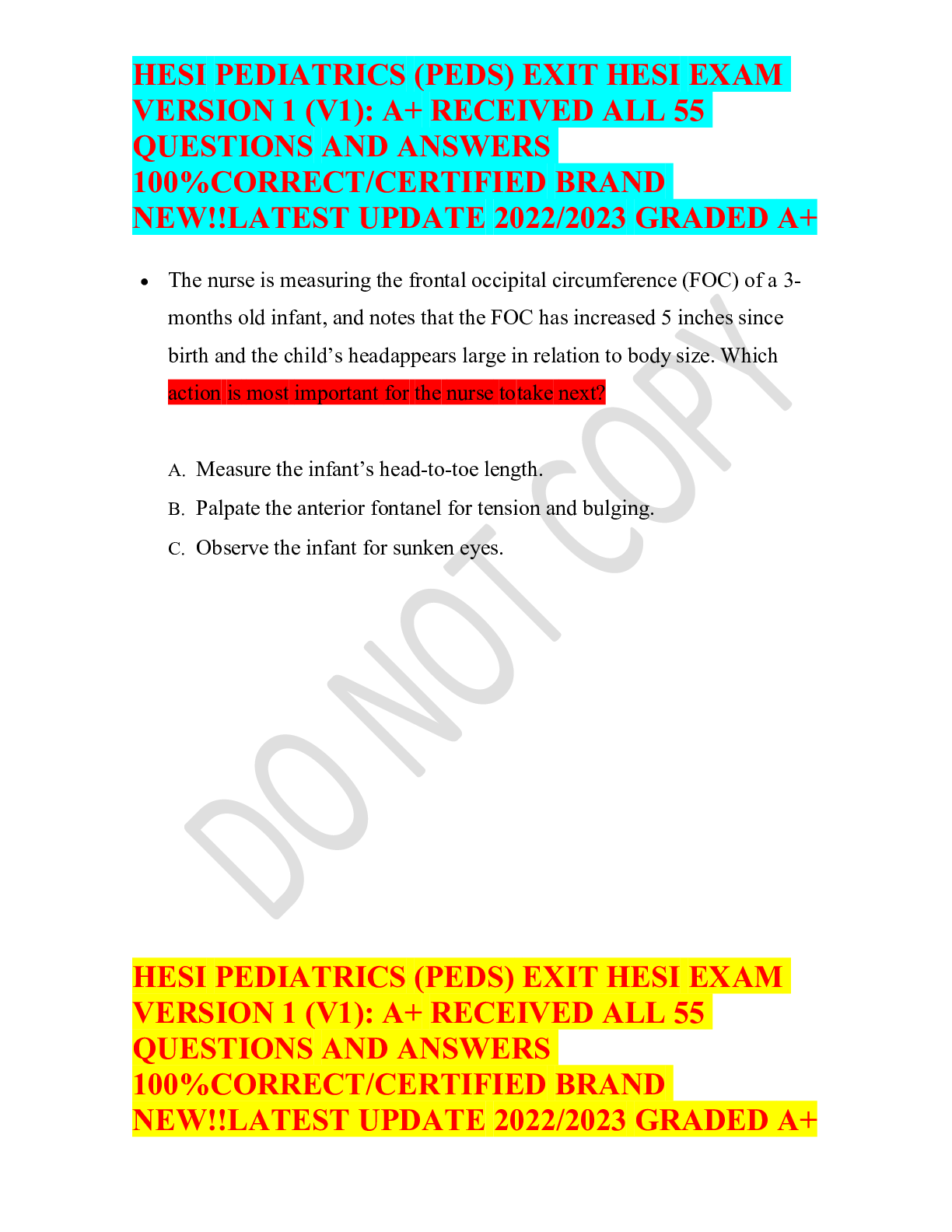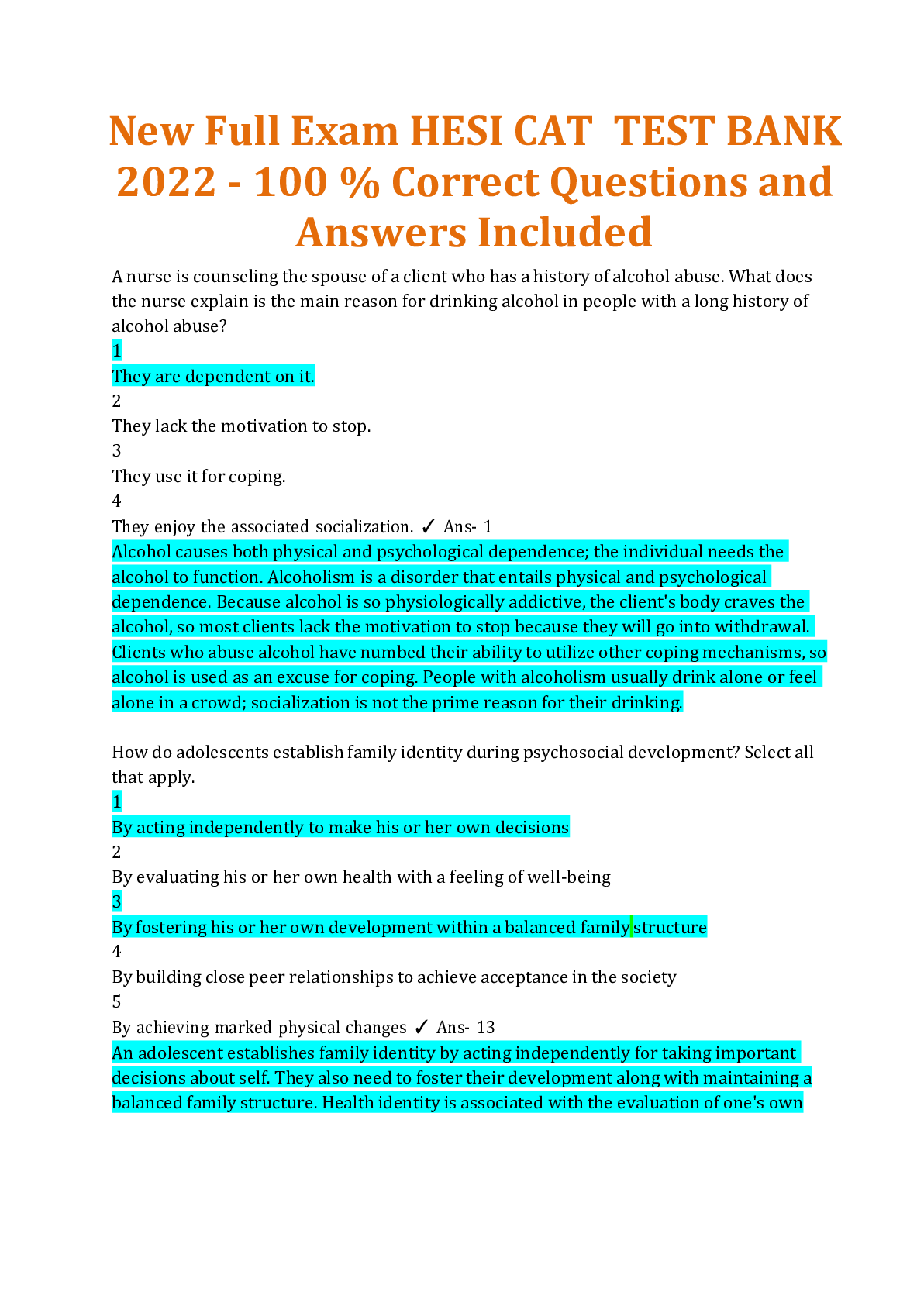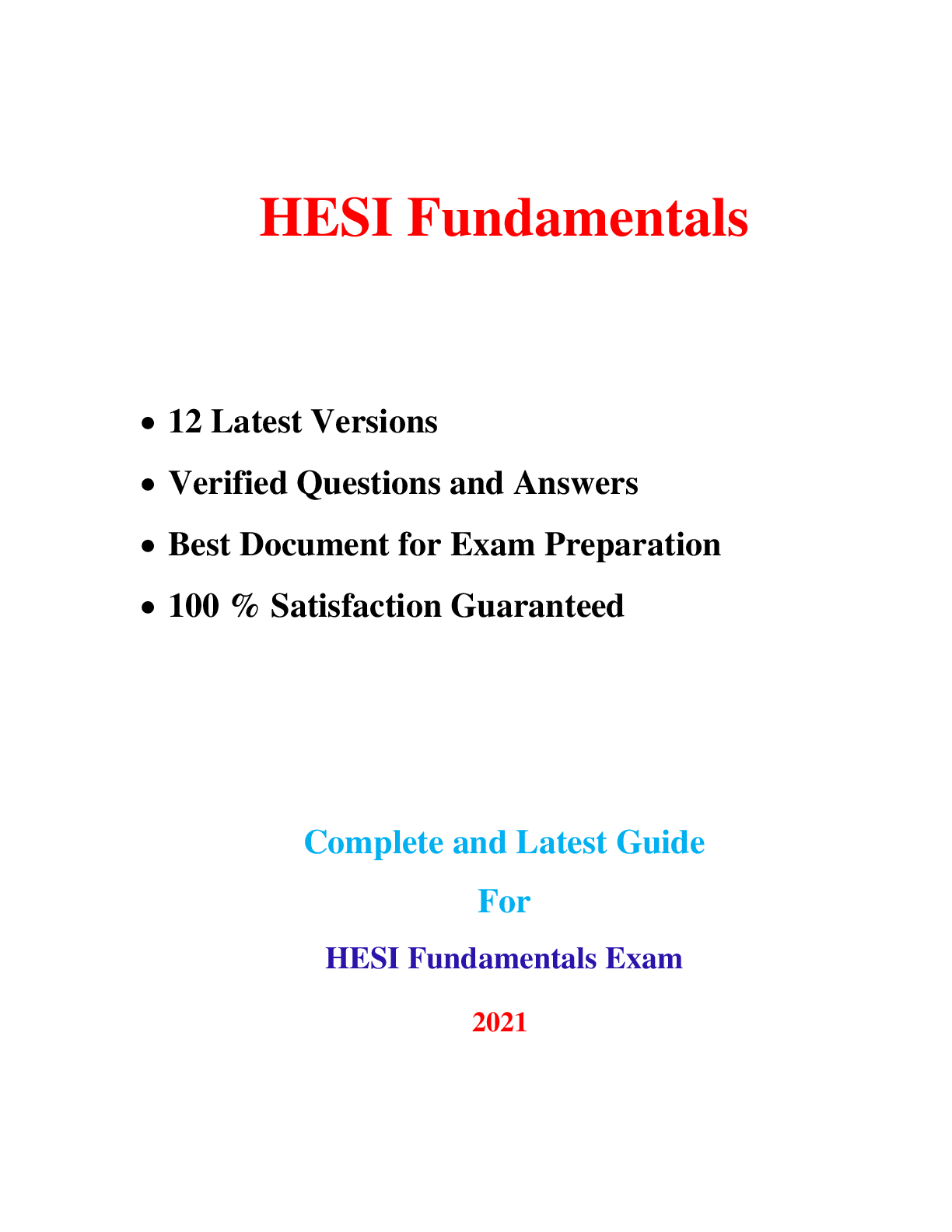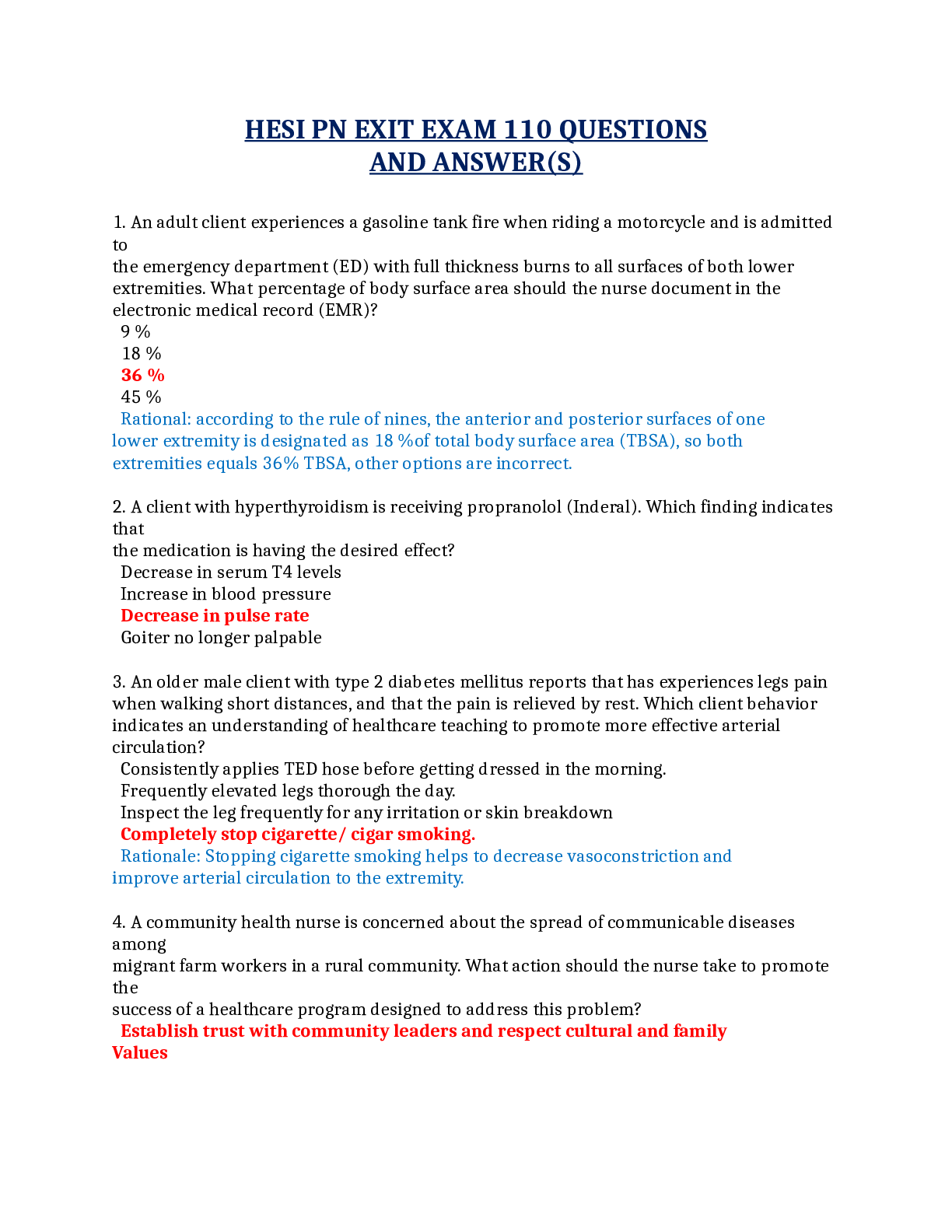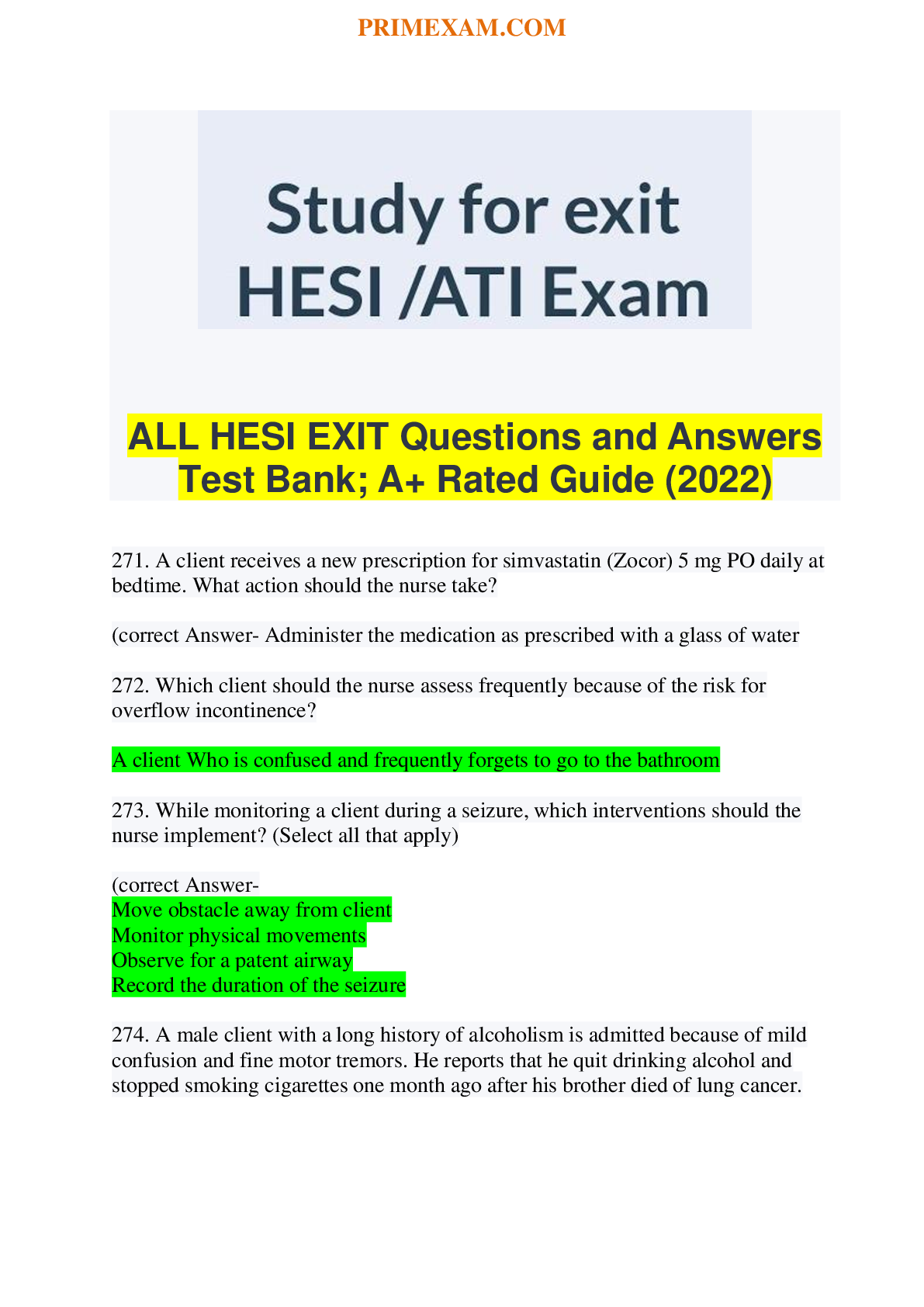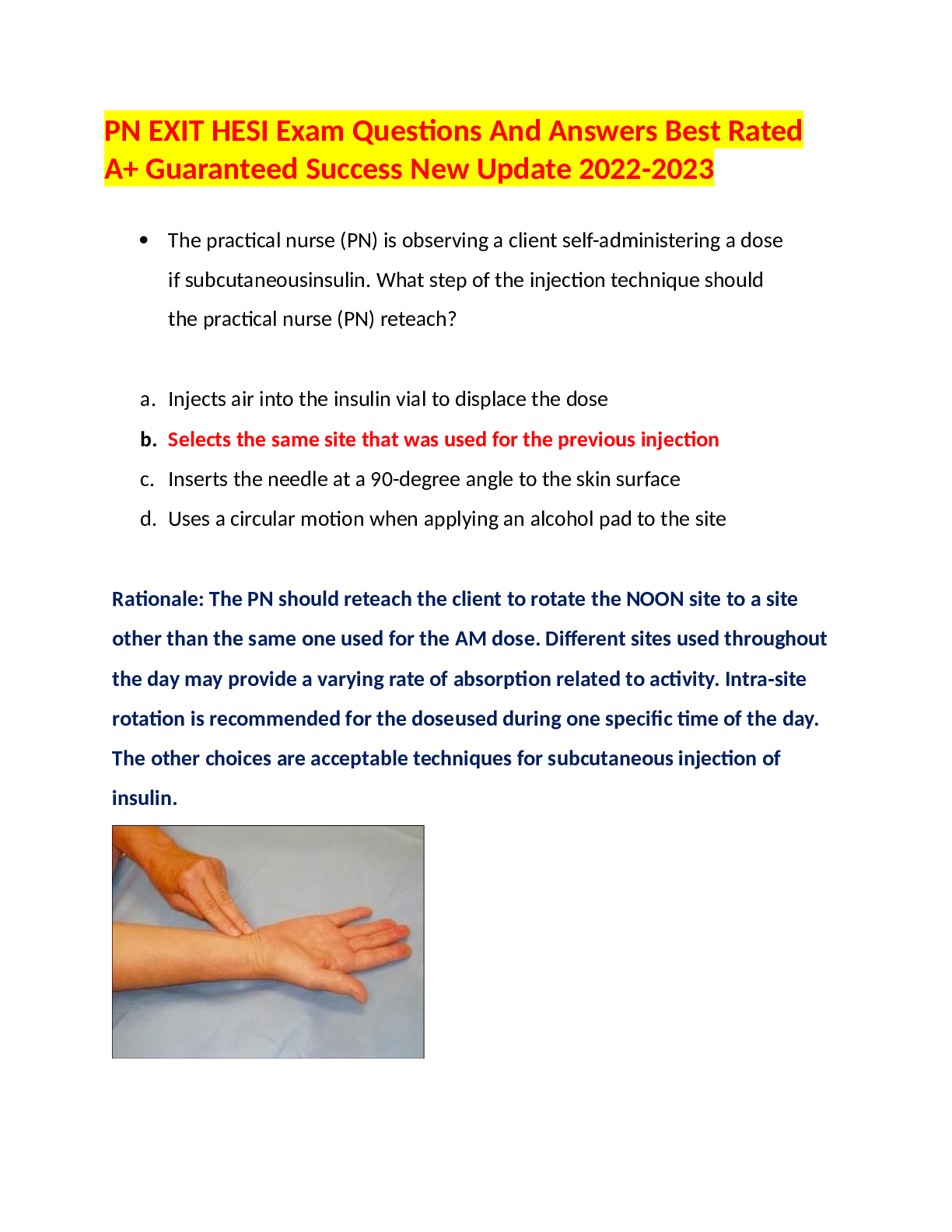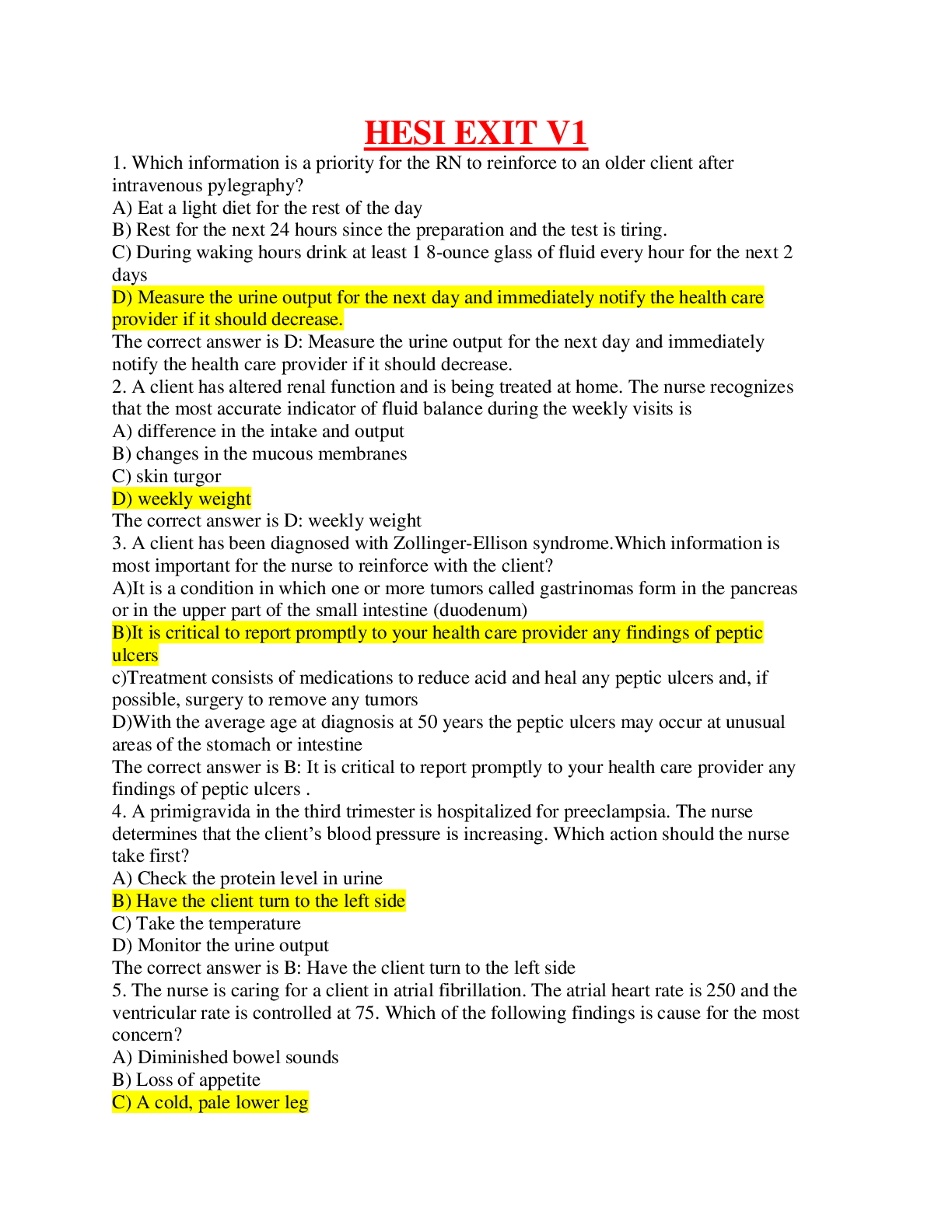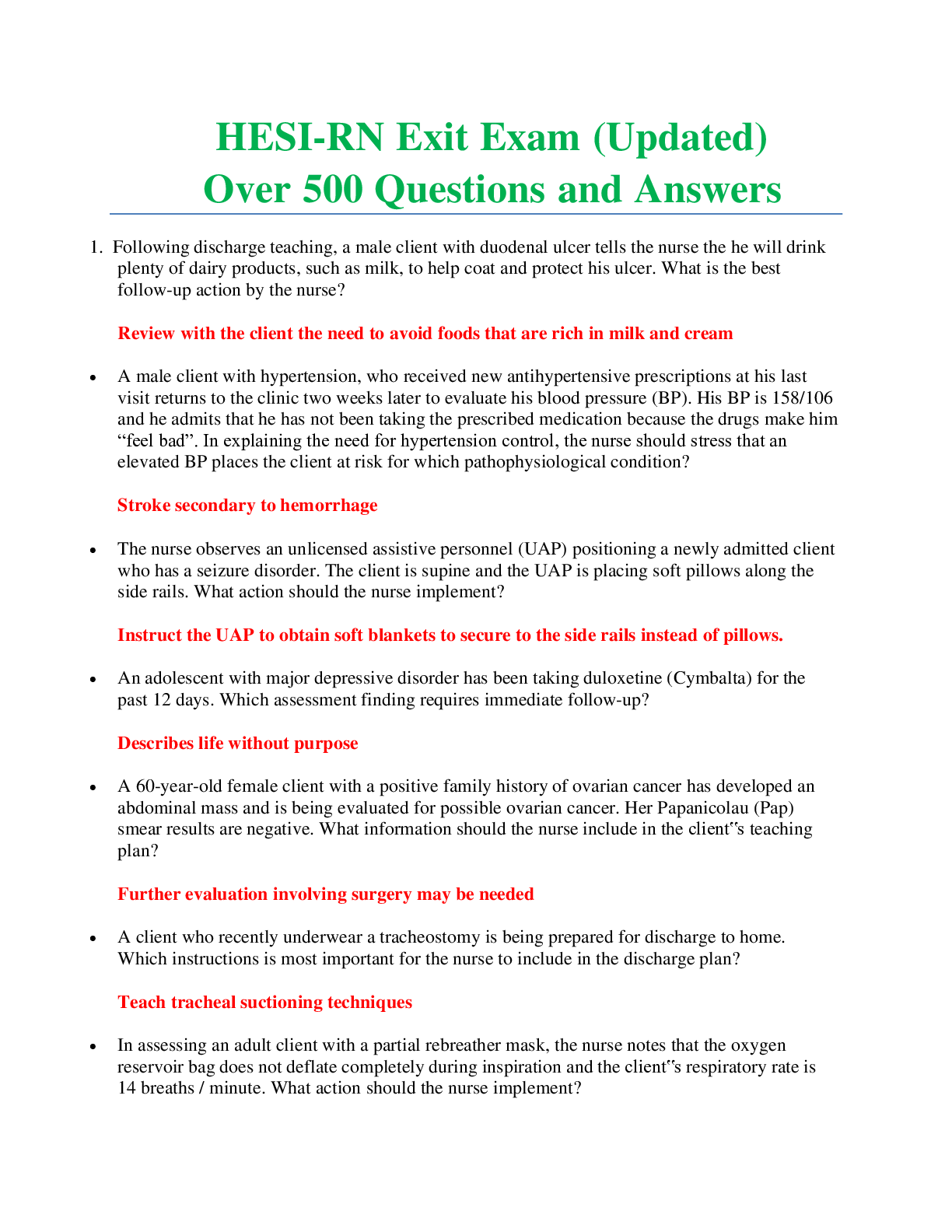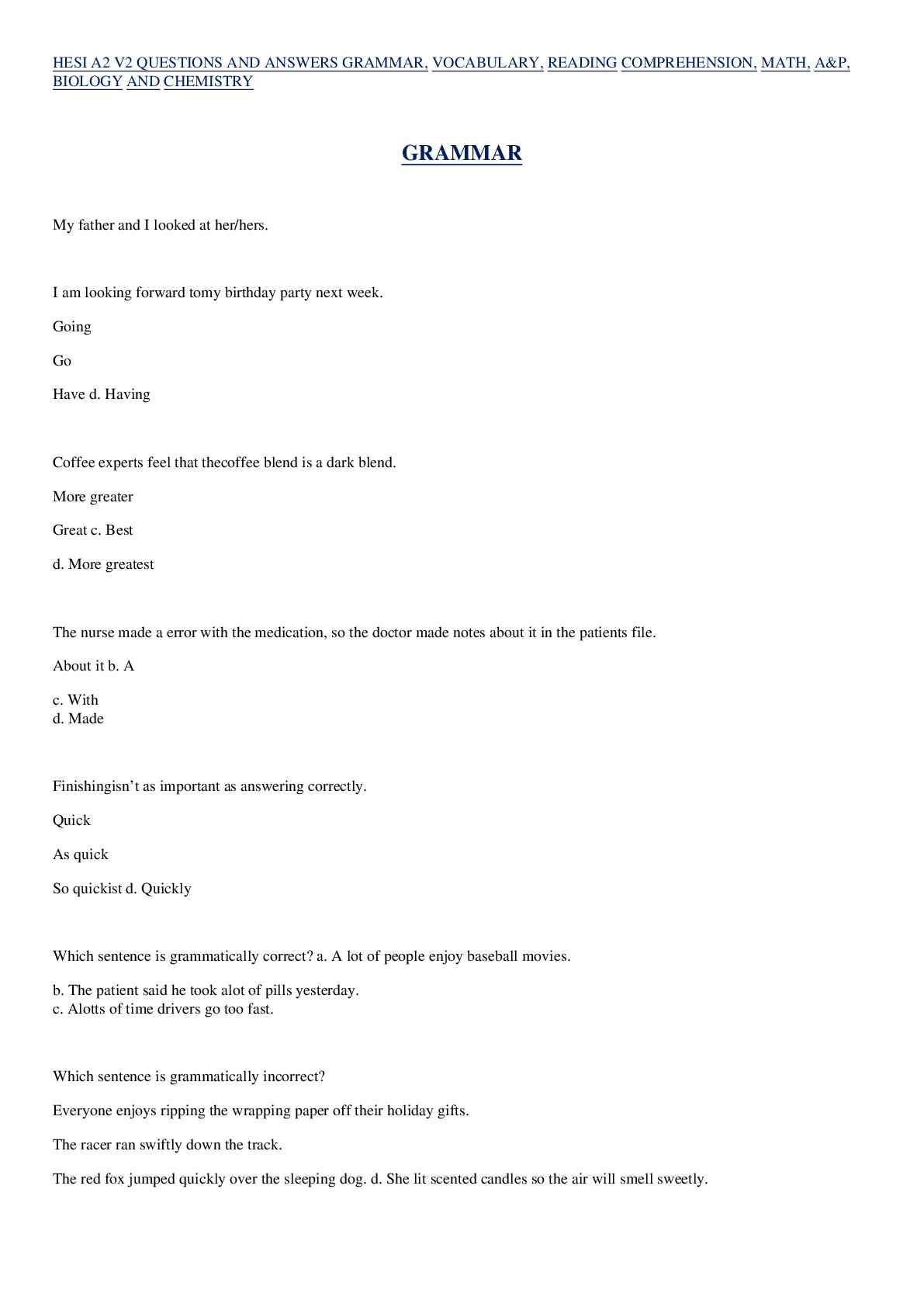*NURSING > HESI > Maternity (Practice) HESI (1)/ (Oxytocin) | (GRADED A) Questions and Answer Solutions | Download To (All)
Maternity (Practice) HESI (1)/ (Oxytocin) | (GRADED A) Questions and Answer Solutions | Download To Score An A
Document Content and Description Below
Maternity Practice HESI 7 year old diabetes I 6 month old introducing solid foods – should be introduced one at a time, every 4 to 7 days to determine food allergies Digoxin 3 month old with GHD,... miss a dose – if missed in less than 4 hours, gibe dose, if elapsed more than 4 hours, hold and give dose at next scheduled time 36 weeks pregnant, Rh-, bright red vaginal bleeding, nursing intervention rubella vaccine – instruction about use of a reliable method of birth control for 28 days after the rubella vaccine is given 6 years old, rheumatic fever, chorea 1 month old vomiting forcefully after each meal, is afebrile, dehydrated, and pyloric stenosis – olive shaped mass in the abdominal area that is evident at diaper change 18 weeks gestation, high AFP level – need for follow up evaluation with a sonogram to provide visual evidence of fetal age and presence of neural tube defects left breast mastitis, instruction to do at home magnesium sulfate, toxicity signs continuous fetal monitoring, V shaped appearance child with suspected bacterial meningitis, would have a recent history of unrelated bacterial upper respiratory, sinus, or ear infection - ear ache HIV+, receiving AZT during labor diaphragm size – after each birth the diaphragm should be evaluated for correct sizing and use an alternative form of contraception until verified Type I, 35 weeks gestation, amniocentesis Dilantin, newly diagnosed tonic – clonic epilepsy, seizure management – child should have routine serum levels monitored, as well as liver function infant with barking cough, fever, runny nose – croup, mother should the baby in the bathroom steamed up with hot water from tub or shower osteomyelitis foods to eat, 6 years old – high protein/high calories, milk shake is best choice 4 year old DMD symptoms – teach parents about these changes so they can prepare and help protect child from injuries pelvic inflammatory disease (PID) - IV antibiotics tonsillectomy, bleeding action – assess for bleeding with illumination to visualize oropharynx Ceftriaxone, + gonorrhea APGAR, 1/10, color is acrocyanotic young girl, UTI 9 year old, celiac disease, appendectomy, food to not eat – crackers = have gluten history of preeclampsia, high blood pressure what to use when changing newborn’s diaper – plain water 18 year old daughter, serum test results 38cm fundal height, 30 weeks gestation – after 20 weeks, the fundal height in cm should approximate # of weeks gestation 5 year old, bowel movement, yellow, sticky, smells like sour milk – typical for breastfed newborns, continue to breastfeed absence of testes on newborn admission assessment 3 month old does not sleep through the night 14 month old, hospitalized – febrile seizures 3 year old girl, blind since birth, hospitalized, compound fracture of the femur and is now in traction, intervention fundal massage technique – anchor the lower uterine segment with one hand, while massaging the fundus with the other hand, to prevent uterine prolapse and uterine inversion Maternity HESI 4. The nurse is teaching a client with gestational diabetes about nutrition and insulin need for pregnancy. Which content should the nurse include in this client’s teaching plan? A) Insulin production is decreased during pregnancy B) increase daily caloric intake is needed ? C) injection requirements remain the same D) Blood sugars need less monitoring in the first trimester 5. A 38-week primigravida client who is positive for Group A Beta Streptococcus receives a prescription for cefazolin 2 grams IV to be infused over 30 minutes. The medications available in 2 grams/100 ml of normal saline. The nurse should program the infusion pump to deliver how many ml/hour? 1.6ml/hr 7. When performing the daily head-to-toe assessment of a 1-day-old newborn, the nurse observes yellow tint to the skin on the forehead, sternum, and abdomen. What action should the nurse take? A) Measure bilirubin levels using transcutaneous bilirubinometry B) Review maternal medical records for blood type and Rh factor C) Prepare the newborn for phototherapy ? D) Evaluate cord blood Coomb’s test results 8. A new mother asks the nurse about an area of swelling on her baby’s head near the posterior fontanel that lies across the suture line. How should the nurse respond? A) “That is called caput succedaneum. It will absorb and cause no problems.” B) “That is called a cephalhematoma. It will cause no problems.” ? C) “That is called a cephalhematoma. It can cause jaundice as it is absorbed.” D) “That is called caput succedaneum. It will have to be drained.” 9.A 39-week-gestational multigravida is admitted to labor and delivery with spontaneous rupture of membranes (SROM) and contractions occurring every 2 to 3 minutes. A vaginal exam indicates that the cervix is dilated 6 cm, 90% effaced, and the fetus is at a +2 station. During the last 45 minutes the fetal heart rate (FHR) has ranged between 170 and 180 beats/minute. What action should the nurse implement? A) Obtain a blood specimen for hemoglobin B) Take an oral maternal temperature ? C) Straight catheterize the client D) Send amniotic fluid for analysis 10. An obviously pregnant woman walks into the hospital’s emergency department entrance, shouting, “Help me! Help me! My baby is coming! I’m so afraid!” The nurse determines if delivery is indeed imminent. What action is most important for the nurse to take? A) Determines the gestational age of the fetus B) Assess the amount and color of the amniotic fluid C) Obtain peripheral IV access and begin administration of IV fluids D) Provide clear, concise instructions in a calm, deliberate manner 11. During a routine prenatal health assessment for a client in her third trimester, the client reports that she had fluid leakage on her way to the appointment. Which technique should the nurse implement to evaluate the leakage? A) Palpate suprapubic area for fetal head position B) Insert straight urinary catheter to drain bladder C) Test the fluid with a nitrazine strip D) Scan the bladder for urinary retention 12. A client who is 3-weeks postpartum tells the nurse, “I am so tired all the time. I didn't know having a baby would be so hard.” What response should the nurse provide? A) It is common to feel exhausted for the first 3 months. Try to sleep when the baby sleeps. B) It is normal to feel tired for the first couple weeks. Be patient with yourself and rest more. C) You should not be doing any housework. Are any of your family members helping you? D) Adjusting to a new baby can be difficult. Tell me more about any help you are receiving. 13. The home health nurse visits a client who delivered a full term baby three days ago. The mother reports that the infant is waking up every 2 hours to bottle feed. The nurse notes white, curd-like patches on the newborn’s oral mucous membranes. What action should the nurse implement? A) Discuss the need for medication to treat curd-like oral patches B) Suggest switching the infant’s formula C) Assess the baby’s blood glucose level D) Remind mother not put the baby to bed with a propped bottles 16. Which action should the nurse take if an infant, who was born yesterday weighing 7.5 lbs (3,317 grams), weighs 7 lbs (3,175 grams) today. A) Monitor the stool and urine output of the neonate for the last 24 hours B) Inform and assure the mother that this is a normal weight loss C) Encourages the mother to increase frequency of breastfeeding. D) After verifying the accuracy of the weight, notify the healthcare provider. 17. A term multigravida, who is receiving oxytocin (Pitocin) for labor augmentation, is requesting pain medication. Review of the client’s record indication that she was medicated 30 minutes ago with butorphanol (Stadol) 2 mg and promethazine (Phenergan) 25 mg IV push. Vaginal examination reveals that the client’s cervical dilation is 3 cm, 70% effaced, and at a 0 station. What action should the nurse implement? A) Discontinue the Pitocin infusion B) Medicate the client with an additional 1 mg of Stadol IV push C) Notify the healthcare provider D) Instruct the client to use deep breathing during a contraction 18. A women who delivered a 9 pound baby boy by cesarean section under spinal anesthesia is recovering in the postanesthesia care unit. Her fundus is firm, at the umbilicus, and a continuous trickle of bright red blood with no clots from the vagina in observed by the nurse. Which action should the nurse implement? A) Massage the fundus vigorously B) Assess her blood pressure C) Apply ice pack to perineum D) Let the infant breast feed 21. When teaching a gravid client how to perform kick (fetal movement) counts, which instruction should the nurse include? A) Exercise for 15 minutes before starting the counting to help increase fetal movement B) Count the movements once daily, for one hour, before breakfast C) Avoid caffeinated drinks for 24 hours before conducting the kick test. D) If 10 kicks are not felt within one hour, drink orange juice and count for another hour. 23. A 26-week gestational primigravida who is carrying twins is seen in the clinic today. Her fundal height in measured at 29 cm. Based on these findings, what actions the nurse implement? A) Notify the healthcare provider of the finding B) Document the finding in the medical record C) Schedule the client for a biophysical profile D) Request another nurse measure the fundus 24. The nurse is performing a newborn assessment. Which symptoms, if present in newborn, would indicate respiratory distress? A) Abdominal breathing with synchronous chest movement B) Shallow and irregular respirations C) Flaring of the nares D) Respiratory rate of 50 breaths per minute 25. The nurse is caring for a laboring client who is GBS+ (Group B streptococcus). Which immediate treatment is indicated for this client? A) Administration of Pitocin B) Artificial rupture of the membranes C) Amnioinfusion for the baby D) Administration of antibiotics 26. The nurse examines a client who is admitted in active labor and determines the cervix is 3 cm dilated, 50% effaced, and the presenting part is at 0 station. An hour later, she tells the nurse that she wants to go to the bathroom. Which action should the nurse implement first? A) Check the pH of the vaginal fluid B) Review the fetal heart rate pattern C) Palpate the client’s bladder D) Determine cervical dilation ? 27. The nurse’s assessment of a preterm infant reveals decreased muscle tone, signs of respiratory difficulty, irritability, and mottled, cool skin. Which intervention should the nurse implement first? A) Position a radiant warmer over the crib B) Assess the infant’s blood glucose level C) Nipple feed 1 ounce 5% glucose in water D) Place the infant in a side-lying position 28. Which content should the nurse plan to include in a nutrition class for pregnant adolescents? (Select all that apply) A) Take iron and calcium supplements daily ? B) Gain no more than 15 pounds during the pregnancy C) Increase food intake by 300 to 400 calories/day ? D) Take folic acid supplements daily ? E) Maintain current protein intake ? 29. The healthcare provides prescribes 10 units/L of oxytocin (Pitocin) via IV drip to augment a clients labor because she is experiencing a prolonged active phase. Which finding would cause the nurse to immediately discontinue the oxytocin? A) uterus is soft B) contraction duration of 100 seconds C) four contractions in 10 minutes D) Early deceleration of fetal heart rate 30. A new mother who is breastfeeding her 4-week old infant and has type 1 diabetes, reports that her insulin needs have decreased since the birth of her child. What action should the nurse implement? A) Inform her that a decreased for insulin occurs while breastfeeding B) Advice the client to breastfeed more frequently C) Counsel her to increase her caloric intake D) Schedule an appointment for the client with diabetic nurse educator 31. A diabetic client delivers a full-term large-for-gestation-age (LGA) infant who is jittery. What action should the nurse take first? A) Administer oxygen B) Feed the infant glucose water (10%) C) Obtain a blood glucose level D) Decrease environmental stimuli 32. The postpartum admission prescription for a client who delivered a healthy newborn includes one liter of lactated ringers with oxytocin 20 units to infuse over 8 hours. How many milliunits /minute is the clients receiving? 33. A pregnant, homeless woman who has received no prenatal care presents to the clinic in her third trimester because she is having vaginal bleeding, but reports that she is not in pain. Ultrasound reveals a placenta previa. Which actions should the nurse implement? A) Schedule weekly prenatal appointments B) Contact social services for a temporary shelter C) Obtain a hemoglobin and hematocrit level D) Have the client transported to the hospital 34. The nurse is planning a class for pregnant women in the first trimester of pregnancy. Which information is most important for the nurse to include in the class? A) Plan rest periods and increase sleep time to 8 hours per day when fatigued B) If any vaginal bleeding occurs, notify the healthcare provider immediately C) Since eating often relieves nausea, carry low fat snacks to eat whenever nausea occurs D) If morning dizziness occurs, rise slowly and sit on the side of the bed for one minute 35. When assessing a pregnant woman at 39-weeks gestation who is admitted to labor and delivery, which finding is most important to report to the health care provider? A) +1 proteinuria B) 130/70 blood pressure C) +1 pedal edema D) 101.2 F oral temperature 36. A client who suspects she is pregnant tells the nurse she has a peptic ulcer that is being treated with misoprostol (Cytotec), a synthetic prostaglandin E drug. How should the nurse respond? A) “You may be at risk for having a spontaneous miscarriage” ? B) “You may have an increased chance of having preeclampsia” C) “This medication will have no effect on your unborn child” D) “You may experience postpartum hemorrhaging after delivery” 38. After delivery of a normal infant, the mother tells the nurses that she would like to use oral contraceptives. Which finding in the client’s health history is a contraindication of the use of contraceptives? A) Previously used an intrauterine device (IUD) B) Reported history of stroke within the family C) Diagnosed with diabetes mellitus 2 years ago D) Smoked cigarettes prior to becoming pregnant ? 39. When planning care for a laboring client, the nurse identifies the need to withhold solid foods while the client is in labor. What is the most important reasons for this nursing intervention? A) Nausea occurs from analgesics used during labor B) Autonomic nervous system stimulation during labor decreases peristalsis C) An increased risk of aspiration can occur if general anesthesia is needed D) Gastric emptying time decreases during labor. 40. The parents of a male newborn have signed an informed consent for circumcision. Which intervention should the nurse implement upon completion of the circumcision? A) Place petroleum gauze dressings on the site ? B) wrap the infant in warm receiving blankets C) Give a PRN dose of liquid acetaminophen D) Offer a pacifier dipped in glucose water 42. At 6 weeks gestation, the rubella titer of a client medication indicates she is non-immune. When is the best time to administer a rubella vaccine to this client? A) After the client stops breastfeeding B) Immediately, at 6-weeks gestation, to protect this fetus C) After the client reaches 20-weeks gestation D) Early postpartum, within 72 hours of delivery 44. A woman in her third trimester of pregnancy has been in active labor for the past 8 hours and cervix dialed 3 cm. The nurse’s assessment findings and electronic fetal monitoring (EFM) are consistent with hypotonic dystocia, and the healthcare provider prescribes an oxytocin (Pitocin) drip. Which data is most important for the nurse to monitor? A) Client’s hourly blood pressure B) Preparation for emergency cesarean birth C) Intensity, interval, and length of contractions D) Checking the perineum for bulging 45. The nurse is caring for a newborn who is 18 inches long, weighs 4 pounds, 14 ounces, has a head circumference of 13 inches, and a chest circumference of 10 inches. Based on these physical findings, assessment for which condition has the highest priority? A) Hyperthermia B) Hyperbilirubinemia C) Polycthemia D) Hypoglycemia 47. A client who is anovulatory and has hyperprolactinemia is being treated for infertility with metformin (Glucophage), menotropins (Repronex, Menopur), and human chorionic gonadotropin (hCG). Which side effects should the nurse tell the client to report immediately? A) Episodes of headache and irritability B) Nausea and vomiting C) Rapid increase in abdominal girth D) Persistent daytime fatigue M 48. At 0600 while admitting a woman for a scheduled repeat caesarean section (C-section), the client tells the nurse that she drank a cup of coffee at 0400 because she wanted to avoid getting a headache. Which action should the nurse take first? A) Contact the client’s obstetricianaz B) Ensure preoperative lab results are available C) Inform the anesthesia care provider D) Start prescribed IV with Lactated Ringer’s 49. Following the vaginal delivery of a 10-pound infant, the nurse assesses a new mother’s vaginal bleeding and finds that she has saturated two pads in 30 minutes and has a boggy uterus. What action should the nurse implement first? A) Have the client empty her bladder ? B) Inspect the perineum for lacerations C) Increase oxytocin (Pitocin) IV infusion D) Perform fundal massage until firm 51. A 33-year-old client at 9 weeks gestation tells the nurse that while she has “cut down,” she still has at least one alcoholic drink every evening before bedtime. What intervention should the nurse implement? A) Notify child protective services of the client’s illicit drug use and probable child endangerment B) Praise the client for her actions and offer to discuss ways to decrease consumption even more C) Insist that the client stop all alcohol use and draw a blood alcohol level at each prenatal visit ? D) Refer the client to an outpatient alcohol abuse program for disulfiram (Antabuse) therapy 8. When evaluating the effectiveness of a client’s nursing care, the nurse first reviews the expected outcomes identified in the plan of care. What action should the nurse take next? A) Modify the nursing interventions to achieve the clients goals. B) Determine if the expected outcomes were realistic. C) Review related professional standards of care. D) Obtain current client data to compare with expected outcomes. A male client has right-sided hemiplegia following a left cerebrovascular accident (CVA). His sitting balance has improved, and he is now able to sit In a wheelchair. To assist the client in transferring from the bed to a wheelchair, what action should the nurse take? A) Have the client put both arms around the nurse’s neck for support. B) Place the wheelchair on the client’s left side. C) Instruct the client to look at his feet. D) Instruct the client total slow, deep breaths while transferring. A 16-year-old gravida 1, para 0 client has just been admitted to the hospital with a diagnosis of eclampsia. She is not presently convulsing. Which intervention should the nurse plan to include in this client’s nursing care plan? A) Keep an airway at the bedside B) Assess temperature every hour C) Monitor blood pressure, pulse, and respirations every 4 hours ? D) Allow liberal family visitation The 2-hour exam a newborn delivered by cesarean section reveals nasal flaring, visible retractions, audible grunting, and a dusky skin color. Current vital signs are: axillary temp 98.5 F, pulse 148 beats/minute, and respiration 67 breaths/minute. Which intervention should the nurse implement first? A) Determine the infant’s blood glucose level B) Delay giving the infants initial bath for one hour C) Notify the healthcare provider of the infants current status ? D) Place a pulse oximeter on the infants foot A primipara client at 42-weeks gestation is admitted for induction. Within one hour after initiating an oxytocin (Pitocin) infusion, her cervix is 100% effaced and 6cm dilated, contractions are occurring every 1 minute with a 75 second duration. The nurse stops the Pitocin and starts oxygen. After 30 minutes of uterine rest, the contractions are occurring every 5 minutes with a 20 second duration. Which intervention should the nurse implement? A) Stop oxygen per canula B) Check for clonus in both feet C) Notify nursery about the clients response ? D) Restart Pitocin infusion rate per protocol A client at 32-weeks gestation presents with extreme abdominal tenderness and a small amount of bright red vaginal bleeding. Her blood pressure is 95/65, respiratory rate is 24 breaths/minute, and her heart rate is 116 beats/minute. She is dizzy, with cold, clammy skin. Which prescription has the highest priority? A) Type and cross-match for 4 units of whole blood B) Insert a foley catheter C) Lactated Ringers at 200ml/hr using an 18 gauge needle D) Monitor oxygen saturation rate per pulse oximeter ? Following a precipitous labor, a postpartum client has a continuous trickling of bright red blood from her vagina. Her uterus is firming, her vital signs are within normal limits. The nurse determines that this sign may indicate which condition? A) Expected course in fourth stage of labor B) Early postpartum hemorrhage C) A full urinary bladder ? D) Laceration on the cervix At 20-weeks gestation, a client who has gained 20 pounds during this pregnancy tells the nurse that she is feeling fetal movement. Fundal height measurement is 20 cm, and the client’s only complaint is that her breasts are leaking clear fluid. Which assessment finding warrants further evaluation? A Presence of fetal movement B Gestational weight gain C Fundal height measurement D Leakage from breasts A client at 40-weeks gestation presents to the obstetrical floor and indicates that the amniotic membranes ruptured spontaneously at home. She is in active labor, and feels the need to bear down and push. What information is most important for the nurse to obtain first? A Estimated amount of fluid B Any odor noted when membranes ruptured C Color and consistency of fluid D Time the membranes ruptured An infant with tetralogy of Fallot becomes acutely cyanotic and hyperpneic. What action should the nurse implement first? A Place the infant in a knee-chest position B Administer morphine sulfate C Start intravenous fluids D Provide 100% oxygen by face mask A one-day-old neonate develops a cephalhematoma. The nurse should closely assess this neonate for which common complication? A Jaundice B Poor appetite C Brain damage D Hypoglycemia The nurse is reviewing the serum laboratory finding for a 5-day-old infant with congenital adrenal hyperplasia. Which laboratory results should be reported to the healthcare provider immediately? A Bilirubin of 1.5 mg/dL B Glucose of 80 mg/dL C Potassium of 4.5 mEq/L D Sodium of 119 mEq/L A breastfeeding infant, screened for congenital hypothyroidism, is found to have low levels of thyroxine (T4), and high levels of thyroid stimulating hormone (TSH). What is the best explanation for this finding? A The thyroxine level is low because the TSH level is high B High thyroxine levels normally occur in breastfeeding infants C The thyroid gland does not produce normal levels of thyroxine for several weeks after birth D The TSH is high because of the low production of T4 by the thyroid A primigravida arrives at the observation unit of the maternity unit because thinks is in labor. The nurse applies the external fetal heart monitor and determines that the fetal heart rate is 140 beats/minute and the contractions are occurring irregularly every 10 to 15 minutes. What assessment finding confirms to the nurse that the client is not labor at this time? D. Contractions decrease with walking. The nurse is assessing a 2-hour-old infant born by cesarean delivery at 39-weeks gestation. Which assessment finding should receive the highest priority when planning the infant’s care? A Blood pressure 76/42 B Faint heart murmur C Respiratory rate 76 breaths/minute D Blood glucose 45 mg/dL The parents of a newborn tell the nurse that their baby is already trying to walk. How should the nurse respond? A Encourage the parents to report this to the healthcare provider B Acknowledge the parents’ observation C Schedule the newborn for further neurological testing D Explain the newborn’s normal stepping reflex During the admission procedure of a 6-year-old, the child states, “I’m going to have an operation.” Which response is best for the nurse to provide this child? A Are you scared? B We’re going to do everything we can to take very good care of you. C Tell me what an operation is. D I’m glad your mother told you why you were coming to the hospital. ? One day after vaginal delivery of a full-term baby, a postpartum client’s white blood cell count is 15,000/mm^3. What action should the nurse take first? A Check the differential, since the WBC is normal for this client B Assess the client’s temperature, pulse, and respirations q4h C Notify the healthcare provider, since this finding is indicative of infection D Assess the client’s perineal area for signs of a perineal hematoma The mother of a preschool-age child calls the school nurse to report that her child was bitten by a tick while on a school outing last week. The mother tells the nurse that she removed the tick and flushed it down the toilet. What action should the nurse take? A Refer the mother to the center for disease control B Report the incident to the school principal C Culture the site when the child returns to school D Schedule a test for Lyme disease if a rash appears Albumin 25% IV is prescribed for a child with nephrotic syndrome. Which assessment finding indicates to the nurse that the medication is having the desired effect? A Weight gain B Reduction of fever C Improved caloric intake D Reduction of edema The nurse is conducting postpartum teaching with a mother who is breastfeeding her infant. When discussing birth control, which method should the nurse recommend to this client as best for her to use in preventing an unwanted pregnancy? A Breastfeed exclusively at least every 3 to 4 hours B Condoms and contraceptive foam or gel C Rhythm method (natural family planning) D Combined estrogen-progesterone oral contraceptives ?? 1. A full-term, 24-hour-old infant in the nursery regurgitates and suddenly turns cyanotic. What should the nurse do first? D. Stimulate the infant to cry. A community health nurse visits a family in which a 16-year-old unmarried daughter is pregnant with her first child and is at 32-weeks gestation. The client tells the nurse that she has been having intermittent back pain since the night before. What is the priority nursing intervention? A Ask the client’s mother to call an ambulance for transport to the hospital immediately B Determine what physical activities the client has performed for the past 24 hours C Teach the client how to perform pelvic rock exercises and observe for correct feedback ? D Ask the client if she has experienced any recent changes in vaginal discharge A young girl with a fractured radius has a cast applied. As the cast is drying, it is elevated above the level of her heart. Which assessment finding should the nurse report to the healthcare provider immediately? A Itching sensation under the cast B Swelling of fingers with brisk capillary refill C Numbness and inability to move fingers D Visible bruising above the cast At 39-weeks gestation, a multigravida is having a nonstress test (NST). The fetal heart rate (FHR) has remained non-reactive during 30 minutes of evaluation. Based on this finding, which action should the nurse implement? A Initiate an intravenous infusion B Observe the fetal heart rate pattern for 30 more minutes C Schedule a biophysical profile D Place an acoustic stimulator on the abdomen 1. One hour after delivery, the nurse is unable to palpate the uterine fundus of a client who had an epidural and notes a large amount of lochia on the perineal pad. The nurse massages at the umbilicus and obtains current vital signs. Which intervention should the nurse implement next? **SEE SCREEN SHOT FOR RATIONALE** A. Document number of pad changes in the last hour B. Increase the rate of the oxytocin infusion C. Palpate the suprapubic area for bladder distention D. Provide bedpan to void if unable to ambulate 3. After breast-feeding 10 minutes at each breast, a new mother calls the nurse to the postpartum room to help change the newborns diaper. As the mother begins the diaper change, the newborn spits up the breast milk. What action should the nurse implement first? **SEE SCREEN SHOT FOR RATIONALE** A. Wipe away the spit-up and assist the mother with the diaper change B. Turn the newborn to the side and bulb suction the mouth and nares C. Sit the newborn up and burp by rubbing or patting the upper back D. Place the newborn in a position with the head lower than the feet 7. A client delivers a viable infant, but begins to have excessive uncontrolled vaginal bleeding after the IV Pitocin is infused. When notifying the hcp of the clients condition, what information is most important for the nurse to provide? **FOUND IN EXIT EXAM** A. Total amount of Pitocin infused B. Maternal Blood pressure C. Maternal Apical Pulse rate D. Time Pitocin infusion completed 8. The nurse is caring for a newborn infant who was recently diagnosed with congenital heart defect. Which assessment finding warrants immediate intervention by the nurse? **SEE SCREEN SHOT FOR RATIONALE** A. Sweating during feedings B. Weak peripheral pulse C. Bluish tinge to the tongue D. Increased respiratory rate 9. A client who delivered a healthy newborn an hour ago asks the nurse when can she go home. Which information is most important for the nurse to provide the client? **SEE SCREEN SHOT FOR RATIONALE** A. When there is no significant vaginal bleeding B. When ambulating to void does not cause dizziness C. After the vitamin K injection is given to the baby D. After the baby no longer demonstrates acrocyanosis 10. A client at 33- weeks gestation is admitted with a moderate amount of vaginal bleeding and no contractions are noted on the external monitor. Which intervention should the nurse implement? **SEE SCREEN SHOT FOR RATIONALE** A. Weight perineal pads B. Weight daily C. Measure intake and output D. Ambulate 15 minutes QID 12. A client at 20 weeks gestation comes to the antepartum clinic complaining of vaginal warts (human papillomavirus). What information should the nurse provide this client? **SEE SCREEN SHOT FOR RATIONALE** A. Treatment options, while limited due to the pregnancy, are available (Pregnancy complications are not linked to HPV) B. The client should be treated with Penicillin G C. This client should be treat with acyclovir (Zovirax) D. Termination of the pregnancy should be considered 13. One week after missing her menstrual period, a woman performs an OTC pregnancy test and it is positive. Which hormone is responsible for producing the positive result? **SEE SCREEN SHOT FOR RATIONALE** A. Human placental lactogen B. Gonadotrophin-releasing hormone C. Human chorionic gonadotrophin D. Prostaglandin E2 Aplha 14. A new mother, who is lacto-ovo vegetarian, plans to breastfeed her infant. What information should the nurse provide prior to discharge? A. Avoid using lanolin-based nipple cream or ointment B. Continue prenatal vitamins with B12 while breast feeding C. Offer iron- fortified supplemental formula daily D. Weigh the baby weekly to evaluate the newborns growth 16. A primigravida at 36-weeks gestation, who is Rh negative, experienced abdominal trauma in a motor vehicle collision. Which assessment finding is most important for the nurse to report to the health care provider? A. Fetal heart rate of 162 beats/minute B. Trace of protein in the urine C. Positive fetal hemoglobin test D. Mild contractions every 10 minutes 18. The nurse is counseling a client who is at 6 weeks gestation and is experiencing morning sickness, but does not want to take any drugs for this discomfort. Which herbal supplement is likely to help this client with the nausea she is experiencing? A. Ginko B. Chamomile C. Peppermint D. Ginger 19. The nurse is assessing a postpartum client who delivered a 10 pound infant vaginally two hours ago. The clients fundus is 2 fingerbreadths above the umbilicus, deviated to the right side, and boggy. After the client voids 250 ml of urine using a bedpan, what action should the nurse implement? **SEE SCREEN SHOT FOR RATIONALE** A. Re-evaluate the client in 15 minutes B. Assist the client to the bathroom to void C. Palpate the suprapubic region for distention D. Encourage the client to breastfeed 21. A client who is in active labor is receiving magnesium sulfate and begin to experience slurred speech and decreased reflexes. Which action should the nurse implement first? A. Obtain a serum magnesium level B. Measure the clients hourly urinary output C. Provide an emesis basin for vomiting D. Turn off the magnesium sulfate infusion 23. Calculated by Naegele’s rule, a primigravida client is at 28 weeks gestation. She is moderately obese and carrying twins and the nurse measures her fundal height at 27 cm. During the previous visit 3 weeks ago, the fundal height measured at 28 cm. Based on these findings, what should the nurse conclude? **SEE SCREEN SHOT FOR RATIONALE** A. Fundal height measurement may indicate intrauterine growth retardation B. The healthcare provider needs to be notified immediately since this fundal height measurement is greater than expected C. Confirm the fundal height measurement with another nurse D. Recognize this as a reasonable fundal height measurement for this client 24. Following the vaginal delivery of a large for gestation age (LGA) infant, a woman is admitted to the ICU due to post partum hemorrhaging. The client’s medical record describes Jehovah’s Witness notes as her religion. What action should the nurse take next? A. Inform the client of the critical need for a blood transfusion B. Obtain consent from the family to infuse packed red blood cells C. Clarify the clients wishes about receiving blood products D. Prepare to infuse multiple units of fresh frozen plasma 25. The nurse is assessing a 35 week primigravida with a breech presentation who is expericing moderate uterine contraction every 3-5 minutes. During the examination the client tells the nurse, “I think my water just broke”. Inspection of the perineal area reveals the umbilical cord protruding from the vagina. After activating the call bell system for assistance, what intervention should the nurse implement? **SEE SCREEN SHOT FOR RATIONALE** A. Administer oxygen at 10 liters via face mask B. Don gloves and push the cord back into the vagina C. Wrap the umbilical cord with sterile gauze D. Position the client into a knee-chest position 26. The nurse is discussing involution with a post-partum client. Which statement best indicates that the client understands the effect of breastfeeding on the resumption of menstrual cycle? ** CHAPTER 25 PAGE 621 IN LOWDERMILK** A. “My period will most likely return in 6 to 8 months” B. “I should expect my period to return in 6 to 8 weeks” C. “My period started as soon as the baby was born” D. “While I am breastfeeding, my period may be delayed” 28. A 30- year-old primigravida delivers a 9-pound infant vaginally after a 30- hour labor. What is the priority nursing action for this client? A. Observe for signs of uterine hemorrhage B. Encourage direct contact with the infant C. Assess the blood pressure for hypertension D. Gently massage fundus every four hours 29. A multigravida client in labor is receiving oxytocin Pitocin 4mu/minute to help promote an effective contraction pattern. The available solution is Lactated Ringers 1,000 ml with Pitocin 20 units. The nurse should program the infusion pump to deliver how many ml/hr? **SEE SCREEN SHOT FOR RATIONALE** ANS: 12 33. At 34- weeks gestation, a primigravida is assessed at her bimonthly clinic visist,. Which assessment finding is important for the nurse to report to the hcp? **SEE SCREEN SHOT FOR RATIONALE** A. Increased appetite B. Fetal heart rate of 110 beats/minute C. Fundus below the xiphoid D. Weight gain of 7 pounds 34.A newborn infant is receiving immunization prior to discharge. Which action should the nurse implement? A. Give the first dose of the vaccine for Rotavirus if any sibilings have diarrhea now B. Ask the mother if she wants the infant immunized for Haemophilus influenza C. Prepare the first dose for Diphtheria, tetanus toxoid and acellular pertussis (DTap) D. Obtain signed consent from the mother for administration of hepatitis B vaccine 35. A multiparous woman at 38-weeks gestation with a history of rapid progression of labor is admitted for induction due to signs and symptoms of preeclampsia. One hour after the Pitocin infusion is initiated, she complains of a headache. Her contractions are occurring every 1 to 2 minutes, lasting 60 to 75 seconds, and a vaginal exam indicates that her cervix is 90% effaced and dialted to 6 cm. What intervention is most important for the nurse to implement? A. Turn the client on her left side B. Discontinue the Pitocin infusion C. Prepare for immediate delivery D. Measure deep tendon reflexes 36. Which topic is most important for the nurse to include in a nutrition teaching program for pregnant teenagers?*GREEN PG 276* A. Gestational diabetes B. Iron-deficieny anemia C. Excessive weight gain D. Elevated cholesterol 37. The nurse is assessing a 38- week gestation newborn infant immediately following a vaginal birth. Which assessment finding best indicates that the infant is transitioning well to extra-uterine life? A. Flexion of all four extremities B. Cries vigorously when stimulated C. Heart rate of 22 beats/minute D. A positive Babinki reflex 38. While caring for a laboring client on continuous fetal monitoring, the nurse notes a fetal heartrate pattern that falls and rises abruptly with a “V” shaped appearance. What action should the nurse take first? A. Prepare for a potential cesarean B. Allow the client to begin pushing C. Administer oxygen at 10/L by mask D. Change the maternal position 39. A 32- week primigravida who is in preterm labor receives a prescription for an infusion of D5W 500 ml with magnesium sulfate 20 grams at 1 gram/hour. How many ml/hour should the nurse program the infusion pump? **SEE SCREEN SHOT FOR RATIONALE** ANS: 25 40. During the admission of a newborn, the nurse identifies a localized swelling that does not cross the suture line on the posterior area of the parietal bone. What action should the nurse implement? **GOT THIS ANSWER FROM GREEN HESI BOOK PG 262** A. Assess neurological vital signs every 4 hours B. Apply direct pressure to the caput succedaneum (THIS ONE CROSSES THE SUTURE LINES) C. Submit a request for a stat CT scan of the head D. Notify the pediatrician of the cephalhematoma (THIS ONE DOES NOT CROSS THE SL & IS MORE CRITICAL) 41. The nurse if caring for a postpartum client who is complaining of severe pain and a feeling of pressure in her perineum. Her fundus if firm and she has a moderate lochial flow. On inspection, the nurse finds that a perineal hematoma is beginning to form. Which assessment finding should the nurse obtain first? **SEE SCREEN SHOT FOR RATIONALE** A. Heart rate and blood pressure B. Abdominal contour and bowel sounds C. Urinary output and IV fluid intake D. Hemoglobin and Hematocrit 43. A multiparous client at 38- weeks gestation is admitted to labor and delivery with a compliant of contractions 5 minutes apart. While the client is in the bathroom changing into a hospital gown, the nurse hears a baby crying. What action should the nurse take first? **SEE SCREEN SHOT FOR RATIONALE** A. Inspect the clients perineum B. Turn on the infant warmer C. Notify a healthcare provider D. Push the call light for help 44. A client who is receiving oxytocin (Pitocin) to augment early labor begins to experience hypersystolic or tetanic contractions with variable fetal heart decelerations. Which action should the nurse implement? **GOT FROM A L&D NURSE** A. Reposition the fetal monitor transducers B. Alert the charge nurse to the patients condition C. Turn off the Pitocin infusion **she said this is what the book prolly says to do** D. Decrease the rate of the Pitocin infusion 45. The nurse is assessing a newborn who was precipitously delivered at 38 weeks gestation. The newborn is tremulous, tachycardic, and hypertensive. Which assessment action is most important for the nurse to implement? A. Determine reactivity of neonatal reflexes B. Perform gestational age assessment C. Weight and measure the newborn D. Obtain a drug screen for cocaine 48. A new infant is receiving positive pressure ventilation after delivery. Based on which assessment finding should the nurse initiate chest compressions? **GOT THIS ANSWER FROM GREEN HESI BOOK PAGE 295** A. Apgar score 7 B. Heart rate 54 C. Limp muscle tone D. Central cyanosis 50. The nurse is scheduling a client with gestational diabetes for an amniocentesis because the fetus has an estimated weight of 8 pounds at 36- weeks gestation. This amniocentesis is being performed to obtain which information? **SEE SCREEN SHOT A. Presence of a neural tube defect B. Gender of the fetus C. Fetal lung maturity D. Chromosomal abnormalities 51. Vaginal prostaglandin gel is used to induce labor for a woman who is at 42 weeks gestation. Thirty minutes after insertion of the gel, the client complains of vaginal warmth, and is experiencing 90 second contractions with fetal heart rate decelerations. What action should the nurse implement first? **SEE PAGE CHAPTER 32- PAGE 781 IN LOWDERMILK BOOK** A. Notify the hcp B. Assess the maternal vital signs C. Turn to a side-lying position D. Increase the IV infusion rate 52. A woman who delivered a normal newborn 24 hours ago complains, “ I seem to be urinarting every hour or so. Is that ok?”. Which action should the nurse implement? **SEE SCREEN SHOT FOR RATIONALE** A. Catheterize the client for residual urine volume B. Measure the next voiding, then palpate the clients bladder C. Evaluate for normal involution, then massage the fundus D. Obtain a specimen for urine culture and sensitivity 53. A client whose labor is being augmented with an oxytocin (Pitocin) infusion requests an epidural for pain control. Findings f the last vaginal exam, performed 1 hour ago, were 3 cm cervical dilation, 60% effacement, and a -2 station. What action should the nurse implement first? **SEE SCREEN SHOT FOR RATIONALE** A. Determine current cervical dilation B. Request placement of the epidural C. Give bolus of intravenous fluids D. Decrease the oxytocin infusion rate 54. The health care provider hands a newborn to the nurse after a vaginal delivery. What action is most important for the nurse to implement? **SEE SCREEN SHOT FOR RATIONALE** A. Allow the mother to touch the infant B. Complete a physical assessment C. Place the infant under a warming unit D. Determine the APGAR score 55. The father of a 3- day- old infant who is breast feeding calls the postpartum help line to report that his wife is acting strangely. She is irritable, cannot cope with the baby, and frequently cried for no apparent reason. What information is most important for the nurse to provide to this father? **SEE SCREEN SHOT FOR RATIONALE** A. A fluctuation in hormones in the early postpartum period can cause mood changes B. Recommend giving supplemental bottle feedings to the baby between breast feeding C. Contact the clinic if the behaviors continue for more than two weeks or become worse D. Tell the father to count the newborns number of soiled diapers over the next few days A full term infant is admitted to the newborn nursery 2 hours after delivery. The delivery record reports that the mother is positive for HIV and received AZT intravenously during labor. What action should the nurse implement first ? A. Ensure that AZT is given within 6 hours after birth B. Collect venous specimen for serum glucose level C. Asses for the presence of the Moro reflex D. Obtain consent for the Hep B vaccine 1- A pregnant woman in the first trimester of pregnancy has hemoglobin of 8.6mg/dl and a hematocrit of 25.1%. What food should the nurse encourage this client to include in her diet? -Cheese. -Carrots. -Chicken. -Yogurt. 3- The nurse that the client is experiencing a complication from the amniocentesis? -A Epigastric pain. -B Increased fetal movement. -C Headache and blurred vision. -D Low back pain with pelvic cramping. 6-Which findings of depression in the postpartum client require additional action by the nurse? (Select all that apply). _A Decreased appetite. _B Feeling of sadness. _C Return of lochia rubra. _D Trouble falling as leep. _E Engorged, painful breasts. 7-A 3-hour-old male infant’s hands and feet are cyanotic, and he has an axillary temperature of 96.5 F, respiratory rate of 40 breaths/min, and a heart rate of 165 beasts/min. What nursing intervention is best for the nurse to implement? _A Gradually warm the infant under a radiant heat source. _B Perform a heel-stick to monitor blood glucose level. _C Notify the pediatrician of the infant’s unstable vital signs. _D Administer oxygen by mask at 2l/minute. 8-A woman who delivered a 9 pound baby boy by cesarean section under spinal anesthesia is recovering in the post anesthesia care unit. Her fundus is firm, at the umbilicus, and a continuous trickle of bright red blood with no clots from the vagina is observed by the nurse. Which action should the nurse implement? _A Apply ice pack to perineum. _B Massage the fungus vigorously. _C Let the infant breast feed. _D Assess her blood pressure 9_While assessing a 40-week gestation primigravida in active labor, the client’s membranes rupture spontaneously and the nurse notes that the amniotic fluid is meconium stained. Which additional finding is most important for the nurse to report to the healthcare provider? _A Contractions occurring every 2 to 3 minutes. _B Vaginal exam reveals a cervix 6 cm dilated.e _C Maternal blood pressure of 130/85 mmHg. _D Fetal heart rate of 100 to beast/minute. 10- The nurse working in an antepartal clinic measures a 38cm fundal height on a client who is at 30-week gestation by dates. What action is most important for the nurse to take? _A Ask the client to return to the clinic next week for reassessment of fundal height. _B Record the findings so that an on-going assessment can be properly. _C Obtain a prescription for an ultrasound and schedule it as soon as possible. _D Explain to the client that this finding could indicate she has a twin pregnancy. 11- The nurse is caring for a postpartal client who is exhibiting symptoms of a spinal headache 24 hours following delivery of a normal newborn. Prior to the anesthesiologists arrival on the unit, which action should the nurse perform? _A Insert an indwelling Foley catheter. _B Cleanse the spinal injection site. _C Apply an abdominal binder. _D Place procedure equipment at bedside. 12- The nurse is preparing to draw blood from a newborn to obtain hemoglobin and hematocrit levels. What is the best method to obtain this blood sample? _A Use a small gauge needle to puncture the vastus lateralis. _B Draw blood from the infant”s antecubital vein using a small gauge needle. _C Use a lancet to puncture the outer lateral aspect of the heel. _D Use a butterfly, small gauge needle to do a venous puncture on the hand. 13- The nurse is preparing a client with Type 1 diabetes who is at 35-weeks gestation for an amniocentesis. After obtaining maternal vital signs and a baseline fetal heart rate, which nursing intervention has the highest priority? _A Intiate a heparin lock.? _B Provide family support. _C Review maternal Rhesus (Rh) factor status. _D Obtain a baseline complete blood count. 14- A 34-week primigravida with preeclampsia is receiving Ringer’s Lactate 500ml with magnesium sulfate 20 grams at the rate of 3 grams/hour. How many ml/hours should the nurse program the infusion pump? (Enter numeric value only). 75 ml/h 18- The postpartum admission prescriptions for a client who delivered a healthy newborn includes one liter of Lactated Ringer’s with oxytocin (Pitocin) 20 units to infuse over 8 hours. How many milliunits/minute is the client receiving? (Enter the numerical value only. If round is required, round to the nearest whole number.) 42 19- The nurse is planning care for a client at 30-weeks gestation who is experiencing preterm labor. What maternal prescription is most important in preventing this fetus from developing respiratory distress syndrome? _A Ampicillin 1 Gram IV push q8h. _B Betamethasone (Celestone) 12 mg deep IM. _C Butorphanol 1 mg IV push q2h PRN pain. _D Terbutaline (Brethine) 0.25 mg subcutaneously q15 minutes x 3. 20- A couple, concerned because the woman has not been able to conceive, is referred to a healthcare provider for a fertility workup and a hysterosalpingography is scheduled. Which complaint would indicate to the nurse that the woman’s fallopian tubes are patent? A Back pain. B Leg cramps. C Shoulder pain. D Abdominal pain. 21- The nurse is conducting postpartum teaching with a mother who is breastfeeding her infant. When discussing birt control, which method should the nurse recommend to this client as best for her to use in preventing an unwanted pregnancy? A Condoms and contraceptive foam or gel. ? B Combined estrogen-progesterone oral contraceptives. C Breastfeed exclusively at least every 3 to 4 hours. D Rhythm method (natural family planning). 21-A client at 38-weeks gestation complains of severe abdominal pain. Upon palpation, the nurse notes that the abdomen is rigid. How should the nurse document the findings? A Chorioamnionitis. B Abruptio placenta. C Oligohydramnios. D Placenta previa. 22-A mother asks the nurse what to use when changing her newborn’s diaper. What substance is best for the nurse to recommend to this mother? A Clear water. B Baby lotion. C Talcum powder. D Corn starch powder. 23- A client at 28-weeks gestation whose hemoglobin level is 10.7 mg/dl and hematocrit is 32.3%, tell the nurse that she eats plenty of green vegetables. When the client asks the nurse how the pregnancy might affect the laboratory finding, what information should the nurse provide? A Plasma volume increases, making the blood count appear low. B Almost all women at 28-weeks gestation have anemia. C Increasing intake of protein might improve these values. D It might be necessary to take an iron supplement twice daily. 25- A woman who delivered a 9 pound baby boy by cesarean section under spinal anesthesia is recovering in the post anesthesia care unit. Her fundus is firm, at the umbilicus, and a continuous trickle of bright red blood with no clots from the vagina is observed by the nurse. Which action should the nurse implement? _A Apply ice pack to perineum. _B Massage the fungus vigorously. _C Let the infant breast feed. _D Assess her blood pressure. During a routine prenatal vital a client 32 weeks gestation complains of urinary frequency has increased during the day as well at night. The nurse determines the client is having irregular uterine contractions. What should the nurse implement ? A. Ask the client if she had sexual intercourse yesterday B. Determine if she has change in vaginal discharge C. Collect urine sample from dipstick analysis D. Obtain a midstream urine specimen for culture A 6 year old child with acute infectious diarrhea is placed on a rehydration therapy regulation. What action should the nurse instruct the parents to take if the client begins to vomit ? A. Continue giving ORS frequently small amounts B. Withhold all oral medications C. Supplement ORS with gelatin or chicken broth D. Provide only bottle water 3. The nurse is preparing to administer methylergonovine maleate (Methergine) to a postpartum client. Based on what assessment finding should the nurse withhold the drug? • Respiratory rate of 22 breaths/min • A large amount of lochia rubra • Blood pressure 149/90 • Positive Homan’s sign Note: The only contraindication that has this medicine is HBP, page 581 Matern… book. 4. The nurse is planning care for a 16-year-old, who has juvenile rheumatoid arthritis (JRA). The nurse includes activities to strengthen and mobilize the joints and surrounding muscle. Which physical therapy regimen should the nurse encourage the adolescent to implement? • Begin a training program lifting weights and running • Splint affected joints during activity • Exercise in a swimming pool • Perform passive range of motion exercises twice daily Note: page 1710 MB (Maternity book) 5. A client receiving oxytocin (Pitocin) to augment early labor. Which assessment is most important for the nurse to obtain each time the infusion rate is increased? • Pain level • Blood pressure • Infusion site • Contraction pattern Note: Page 508 MB 7. A neonate who has congenital adrenal hypoplasia (CAH) presents with ambiguous genitalia. What is the primary nursing consideration when supporting the parents of a child with this anomaly? • Discuss the need for cortisol and aldosterone replacement therapy after discharge • Support the parents in their decision to assign sex of their child according to their preference • Offer information about ultrasonography and genotyping to determine sex assignment • Explain that corrective surgical procedures consistent with sex assignment can be delayed Note: page 776 MB 8. The nurse assessing a 9-year old boy who has been admitted to the hospital with possible acute postsreptococcal glomerulonephritis (APSGN). In obtaining his history, what information is most significant? • Back pain for a few days • A history of hypertension • A sore throats last week • Diuresis during the nights Note: Page 1538 MB 9. A loading dose of terbutaline (Brethine) 250 mcg IV is prescribed for a client in preterm labor. Brethine 20 mg is added to 1,000 ml D W. How many ml of the solution should the nurse administer? 13 10. A 36-week primigravida is admitted to labor and delivery with severe abdominal pain and bright red vaginal bleeding. Her abdomen is rigid and tender to touch. The fetal heart rate FHR) is 90 beats/minute, and the maternal heart rate is 120 beats/minute. What action should the nurse implement first? • Alert the neonatal team and prepare for neonatal resuscitation • Notify the healthcare provider from the client’s bedside ? • Obtain written consent for an emergency cesarean section ? • Draw a blood sample for stat hemoglobin and hematocrit Note: S&S of Abruption Placentae …page 366 collaborative cares MB 11. A laboring client’s membranes rupture spontaneously. The nurse notices that the amniotic fluid is greenish-brown. What intervention should the nurse implement first? • Turn the client to her left side • Contact the healthcare provider ? • Assess the fetal heart rate ? • Check the cervical dilation Note: page 202 meconium and intrapartal period MB 12. A 5-year-old child is admitted to the pediatric unit with fever and pain secondary to a sickle cell crisis. Which intervention should the nurse implement first? A. Obtain a culture of any sputum or wound drainage. • Obtain a culture of any sputum or wound drainage • Initiate normal saline IV at 50 ml/hr • Administer a loading dose of penicillin IM • Administer the initial dose of folic acid PO Note: Therapeutic management page 1497 MB. 13. A child has been vomiting for 3 days is admitted for correction of fluid and electrolyte imbalances. What acid base imbalance is this child likely to exhibit? • Respiratory alkalosis • Respiratory acidosis • Metabolic alkalosis • Metabolic acidosis Note: In the book under Vomiting topic I did not find any but I know that when the people has frequent vomits it’s at risk for developing metabolic alkalosis related to the loss of hydrochloric acid. 14. A child admitted with diabetic ketoacidosis is demonstrating Kussmaul respiration. The nurse determines that the increased respiratory rate is a compensatory mechanism for which acid base alteration? • Respiratory alkalosis • Respiratory acidosis • Metabolic acidosis • Metabolic alkalosis Note: page 1617 MB under ketoacidosis. 15. The nurse is caring for a 5-year-old child with Reye’s syndrome. Which goal of treatment most clearly relates to caring for this child? • Reduce cerebral edema and lower intracranial pressure • Avert hypotension and septic shock • Prevent cardiac arrhythmias and heart failure • Promote kidney perfusion and normal blood pressure. Note: Page 1581 MB under therapeutic and nursing care management. 16. A client whose labor is being augmented with an oxytocin(Pitocin) infusion requests an epidural for pain control. Findings of the last vaginal exam, performed 1 hour ago, were 3 cm cervical dilation, 60% effacement, and a 2- station. What action should the nurse implement first? • Decrease the oxytocin infusion rate • Determine current cervical dilation • Request placement of the epidural • Give a bolus of intravenous fluids Note: page 413 MB 17. A child who received multiple blood transfusions after correction of a congenital heart defects is demonstrating muscular irritability and is oozing blood from the surgical incision. Which serum value is most important for the nurse before reporting to the healthcare provider? • CO combining power • Calcium • Sodium • Chloride Note: Transfusions are in the page 1520 -1521, del unico electrolyte imbalance que habla es del K porque lo mas frecuente en las tranfusiones Es hyperkalemia, pero en esta pregunta los s&s no concuerdan con la hyperkalemia y ademas tampoco es una de las opciones de respuesta, por otra parte nos dan el key word de que son varias tranfusiones en donde existe el riesgo que producto del anticoagulante citrate que contienen las tranfusiones y que se encarga de binde o combinarse con el Ca free, entonces este, el calcio este disminuido en sangre y produce estos sintomas. 18. A 6-year-old child is diagnosed with rheumatic fever and demonstrates associated chronic (sudden aimless movements of the arms and legs). Which information should the nurse to the parents? • Muscle tension is decreased with fine motor skill projects, so these activities should be encouraged • The chorea or movements are temporary and will eventually disappear • Permanent life-style changes need to be made to promote safety in the home • Consistent discipline is needed to help the child control the movements Note: page 1474 19. The nurse is measuring the frontal occipital circumference (FOC) of a 3- month-old infant, notes that the FOC has increased 5 inches since birth and the child’s head appears large in relation to body size. Which action is most important for the nurse to take next? • Measure the infant’s head to heel length • Observe the infant for sunset eyes • Palpate the anterior fontanel for tension and bulging • Plot the measurement on the infant’s growth chart Note: page 1595 MB 20. A 16-year-old gravida 1, para 0 client has just been admitted to the hospital with a diagnosis of eclampsia. She is not presently convulsing. Which intervention should the nurse plan to include in this client’s nursing care plan? • Keep airway equipment at the bedside. • Allow liberal family visitation • Monitor blood pressure, pulse, and respirations q4h • Assess temperature q1h Note: page 346 21. During a well-child visit for their child, one of the parent who has an autosomal dominant disorder tells the nurse, “We don’t plan on having any more children, since the next child is likely to inherit this disorder”. How should the nurse respond? • Explain that the risk of inhering the disorder decrease by 50% with each child the couple has • Acknowledge that the next that the next child will inherit the disorder since the first child did not • Encourage the couple to reconsider their decision since the inheritance pattern may be sex-linked • Confirm that there is a 50% chance of their future children inheriting the disorder Note: page 169 MB 22. The nurse is caring for a one-year-old child following surgical correction of hypospadias. The nursing action has the highest priority? • Monitor urinary output • Auscultate bowel sounds • Observe appearance of stool • Record percent of diet eaten Note: page 1534 MB 23. Patient with Duchenne Disease. The nurse has to explain to the mother that: This condition is inherited in an X-linked recessive chromosome pattern Note: page 1733 MB 24. Primipara patient. What is the pet to share time a, home that is not recommended? CAT 25. An infant with letralogy of Fallot becomes acutely cyanotic and hyperpneic. Which action should the nurse implement first? • Administer morphine sulphate • Start IV fluids • Provide 100% oxygen by face mask Note: page 1465 (box) MB 26. The nurse is preparing a 10-year-old with a lacerated forehead for suturing. Both parents and 12 year old sibling at the child’s bedside. Which instruction best supports family? • While waiting for the healthcare provider, only one visitor may stay with the child • All of you should leave while the healthcare provider sutures the child’s forehead • It is best if the sibling goes to the waiting room until the suturing is completed • Please decide who will stay when the healthcare provider begins suturing Note: Critical Thinking question 27. The parents of a 3 year-old boy who has Duchenne muscular dystrophy (DMD) ask “how can our son have this disease? We are wondering if we should have any more children” What information should the nurse provide these parents? • This is an inherited X-linked recessive disorder, which primarly affects male children in the family • The male infant had a viral infection that went unnoticed and iuntreated, so muscle damage was incurred • The XXXX muscle groups of males can be impacted by a lack of the protein dystrophyn in the mother • Birth trauma with a breech vaginal birth causes damage to the spinal cord, thus weakening the muscles Note: page 1733 MB 28. A 4 month old girl is brought to the clinic by her mother because she has had a cold for 2 or 3 days and woke up this morning with a hacking cough and difficulty breathing. Which additional assessment finding should alert the nurse that the child is in acute respiratory distress? • Bilateral bronchial breath sounds • Diaphragmatic respiration • A resting respiratory rate of 35 breathe per minute • Flaring of the nares Note: page 1354 MB 29. A two year old child with a heart failure(HF) is admitted for replacement of a graft for coarctation of the aorta. Prior to administering the next dose of digoxin (Lanoxin) the nurse obtains an apical heart rate of 128 bpm. What action should the nurse implement? • Determine the pulse deficit • Administer the schedule dose • Calculate the safe dose range • Review the serum digoxin level Note: page 1460 MB 30. Which nursing intervention is most important to include in the plan of care for for a child with acute glomerulonephritis? • Encourage fluid intake • Promote complete bed rest • Weight the child daily • Administer vitamin supplements Note: page 1539 MB 31. A 7 year old child is admitted to the hospital with acute glomerulonephritis (AGN). When obtaining the nursing history which finding should the nurse expect to obtain? • High blood cholesterol level on routine screening • Increased thirst and urination • A recent strep throat infection • A recent DPT immunization Note: page 1538 MB • A newborn yellow abdomen and chest Assess bilirubin level • Child HIV Respiratory system • Glomerunephritis Strawberry • Percentile 97 Is in normal high level con respect a las caracteristicas del nino • To confirm RDS in a newborn Diagphrama breathing • Cryptorchidism Put baby in a room and calm the baby • Diaper Clean water • ADHD Encourage the parents to help the baby with homework • Watery vaginal white in the first trimester Is normal • Propanol Decrease headache • Palirizumab (synagis) Is given to high risk baby 2. During a 26-week gestation prenatal exam, a client reports occasional dizziness and lightheadness when she is lying down. What intervention is best for the nurse to recommend to this client. Lie on the left side or right side while sleeping or resting 43. A child with leukemia is admitted for Chemotherapy and the nursing diagnosis " altered nutrion, less those body requirements related to anorexia, nausea and vomiting" is identified. Which intervention the nurse included in this child plan of care? Allow the child to eat any food desired and tolerated. 45. A new mother is having trouble breast feeding her newborn son. He is making frantic rooting motions and will not grasp the nipple. What intervention would be most helpful to this mother? Ask the mother to stop feeding, confront the infant, and then assist the mother to help the baby latch on. 46. A blind litter girld, 8 year sold was admitted to the hospital ..... Bring familiarly toys from home, such as bear,doll. 47. Apple 48. 9 redondiado 49. Preclancia Zeisures 50. A woman with mastitis Ice pack 51. Belling Change the client position before call the doctor. 52. A pregnant woman with hypermesis gravidarium, what is the best nurse intervention. Administered prescribed IV solution. A mother spontaneously delivers her infant in a taxi cab on the way to the hospital. The emergency room nurse reports that the mother has active herpes (HSVII) lesion on the vulva. What intervention should the nurse implement first when admitting the neonate in the nursery? A. Obtain blood specimen for serum glucose level B. Document the temperature on the flow sheet C. Place newborn in the isolation area of the nursery D. Administer Vitamin K injection 1. woman had variable deceleration. What is nursing action? Turn her on her side 2. parents asking nurse why heel stick is important for baby ? It is routine exam to check for metabolic deficiency 3. Coke baby: mother was diagnosed with Coke. Baby is irritable, cries a lot. What do you do? Initiate seizure precaution. 4. Mom has mastitis. She is on antibiotics. Nurse advises patient to: Initially breastfeed on the unaffected breast 5. New mother states her nipples are tender after breastfeeding for 2 days: assess position of infant while breastfeeding 6. Mom unsure about being a good parent: determine support from family, friends 7. Mother has diaphragm after birth. She wants to know if she should get a new one or keep it? Use alternative contraceptives until she can obtain a new one 8. Mother is given Atropine. What to look out for? Increased pulse and dry oral membranes/secretions 9. If mother has DM type 1, what do you expect for fetal complications? Hypoglycemia 10. Pt has history of “heart damage”. She has the potential to have heart failure. What is her nursing diagnosis? fluid volume excess. 11. Mom comes out of room screaming that her baby is missing. What do you do – initiate a lockdown 12. Mom has post partial hemorrhage. What is most likely the cause – she is a multigravida 13. Mom has mitral stenosis, what symptom is common with this diagnosis – persistent cough 14. Pt is administered with anesthesia, what is the highest priority – side rails up and call bell in reach 15. Patient is showing signs of mag toxicity (nausea, feeling of warmth, flushing) – stop infusion Good source of folic acid - peanuts 16. Signs of fetal alcohol syndrome – flat nose bridge Mom has been on mag sulfate and is now postpartum, what is she at increased risk for – uterine atony (hemorrhage) Mom is prescribed hemabate – give antiemetic before hemabate due to s/e (also cause diarrhea so give antidiarrheal) During fundal massage, place one hand at the fundus, what is the second hand used for – to anchor fundus There is a question that has to be put in order – isolate the baby, move mom to private room, collect u/a, start iv How do you measure the frequency of contractions – from the beginning of one to the beginning of the next Mothers Hemoglobin A1C – give her a consultation to a nutritionist Baby shows cyanosis in hands and feet and has elevated respirations – gradually warm the baby Baby is showing signs of mottling – check temperature Mom is at 20 week gestation and has gained 20 lbs, what is of most concern out of the data of mom – increased weight gain Mom asks why her baby is being screened for T4 and TSH levels – it is state protocol to monitor for metabolic abnormalities Patient is having labor back pain – counter pressure on lower back (sacrum) Woman had cleft lip, dads uncle had cleft lip – send them for genetic testing Woman in labor and they look at vagina and see cord – put woman in Trendelenburg position Pregnant woman has a diaphragm – she needs to have it refitted for another diaphragm Baby starts showing signs of respiratory difficulty (nasal flaring, expiratory grunt, cyanosis) – check O2 saturation levels Baby progressing in extrauterine life would show what signs – good vigorous cry with stimulation Baby has peri-oral cyanosis – assess the oral mucosa Before surgery mom is given an anticholinergic/atropine with anesthesia. What is the therapeutic response of the anticholinergic – increase pulse and decrease oral secretions Question about cytotec – answer is you are at an increased risk for abortion Patients uterus is above the umbilicus and to the right during postpartum, what do you do first – palpate the bladder for distention Mom feels the urge to defecate during labor – do a vagina exam What is the reason to do an ultrasound on a mother at 20 weeks gestation – ultrasound for gestation and fetal growth Patient is taking mag sulfate and urine output is 25 mL/hr, respirations 14/min, pulse is 116/min, what should the nurse do first – discontinue mag sulfate (signs of mag tox) Postpartum with bathroom privileges, what possible condition would the nurse place the patient on temporary bed rest for – possible thrombus in the leg if positive Homan’s sign is present Pregnant woman has an increased costal angle and diaphragm is elevated , how does the nurse document this – as a normal finding Moms Hgb and Hct is low, what food to tell her to eat that contains the most iron? – chicken (other sources: liver, meats, whole grains, enriched bread, cereal, dried fruits) Mom wakes up in a pool of blood and comes to emergency room. What to check first – blood pressure 3. A 4-day postpartum client calls the clinic and reports that her nipples are so sore that she does not know if she can continue to breastfeed her infant. What instruction is best for the nurse to provide? C. Let the nipple dry thoroughly after each feeding. 4. A newborn with myelomeningocele is admitted to the neonatal intensive care unit. Which preoperative nursing intervention should the nurse implement first? A. Place the infant on the abdomen to protect the sac. 5. The mother of a 5-week-old tells the nurse that her baby has acne and asks if she can use her teenage son’s acne cream, benzoyl peroxide, on the baby’s face. Which answer should the nurse to provide? A. “ Your baby may be showing signs of a systemic disease and needs to be seen by a healthcare provider” A new mother asks the nurse, "How do I know that my daughter is getting enough breast milk?" Which explanation is appropriate? A. "Weigh the baby daily, and if she is gaining weight, she is getting enough to eat." B. "Your milk is sufficient if the baby is voiding pale, straw-colored urine six to ten times a day." C. "Offer the baby extra bottled milk after her feeding and see if she still seems hungry." D. "If you're concerned, you might consider bottle feeding so that you can monitor intake." 6. Artificial rupture of the membranes of a laboring client reveals meconium-stained fluid. What intervention has the greatest priority? D. Have a meconium aspirator available at delivery. 7. A mother brings her 2-month-old to the well-baby clinic. She states that when she kisses her baby, the infant’s skin tastes salty. The nurse should prepare the mother for what standard diagnostic test to screen for cystic fibrosis (CF)? A. Sweat-chloride test. A primipara has delivered a stillborn fetus at 30-weeks gestation. To assist the parents with the grieving process, which intervention is most important for the nurse to implement? Provide an opportunity for the parents to hold their infant in private A primigravida at 40 weeks gestation is contracting q2 minutes, and her cervix is 9 cm dilated, and 100% effaced. The rate is 120 breaths/minute. The client is screaming and her husband is alarmed. Which intervention should the nurse take? Notify rapid response team Have delivery table set up Ask the husband to step out Administer a PRN narcotic Peds 1. MALE CHILD IN IV THERAPY FOR GROIN ABSCESS: EXPOSURE TO PISON IVY 6 DAYS AGO. 2. SICKEL CELL CRISI. WHICH IS THE EARLIEST SIGN EXHIBIT: PAIN. 3. BABYSITTER OF A 7yold WHO HAS TYPE 1 DIABETES AND IS VERY IRRITABLE, PERSPIRING AND SAHKING. SHE CALL THE NURSE, WHAT IS THE BEST RESPONSE: GIVE THE CHILD AN 8 oz= 1 cup OF MILK. 4. MOTHER OF A 3 MONTHS WHO IS SPITTING UP EVERY TIME SHE BREATS FEED HIM. WHAT ACTION SHOULD THE NURSE TAKE? EXPLAIN THAT SPITTING UP IS NORMAL AND USUALLY IS NOT A PROBLEM . 5. ORDER THE CLIENT HAVE A CRISIS OF DKA FOR THE 2ND TIME IN 5 MONTHS ACCORDING TO THE HIGHST PRIORITY TO THE LOWEST SELECT: 5.1- ASK THE CLIENT 5.2- EVALUATE THE CLIENT KNOWLEGDE ABOUT HIS SIT. 5.3- ASSESS THE CLIENT’S RESOURCES AND FAMILY SUPPORT. 5.4- PROVIDE INFORMATION ABOUT A SUPPORT GROUP. 6. PREGNANT TEENAGER: IRON-DEFICIENCY ANEMIA 7. BABY WITH HYPOSPADIAS, MOTHER CONCERNED R/T JEWISH FAITH TRADITION: “I UNDERSTAND YOUR CONCERN. WOULD YOU LIKE TO TALK W/THE PEDIATRICIAN”? 8. BETA-ADRENERGIC AGONIST ALBUTEROL (PROVENTIL): ASSURE THE MOTHER THAT IS CORRECT. 9. GROUP B STREPTOCOCCUS (GBS), WHICH INMEDIATE TREATMENT: ADMINISTRATION OF ANTIBIOTICS. 10. 8.6 (DOSAGE CALCULATION). 11. NURSE ASSESSING 3yold BOY AFTER AND UPPER RESPIRATORY TRACT INFECTION, HE DEVELOP ACUTE OTITIS MEDIA (OM). WHICH FACTOR PLACES HIM AT GREATEST RISK? CHILDREN HAS THE EUSTACHIAN TUBE IS SHORTER THAT ADULTS. 12. ASHKENAZI JEWISH WOMAN: TAY-SACHS DISEASE (THIS POPULATION ARE MORE SUSCEPTIBLE GENETIC DISEASES LIKE T-S DISEASE = A condition where children develop normally until about four to six months of age. It is at this time that the central nervous system begins to degenerate. Individuals with Tay - Sachs disease lack an enzyme called hexosaminidase (Hex A). The child loses all motor skills and becomes blind, deaf and unresponsive). 13. INDOMETHACIN (INDOCIN): FOR PREMATURE WHO HAS PATTERN DUCTUS ARTERIOSIS = PDT because works by causing the PDA to constrict, and this closes the blood vessel. DECREASE RESPIRATION 14. A CLIENT AT 40 WKS, ACTIVE LABOR, WHO IS HIV+ AFTER A BLOOD TEST. WHAT ACTIONS SHOULD THE NURSE INCLUDE IN THE PLAN OF CARE REGARDING TO THE LABOR PROCESS, SELECT ALL THAT APPLY: 14.1- USE STANDARD PRECAUTION. 14.2- GIVE ANTIVIRAL MEDS (HIV+ MOM’S CANN’T BREASTFEED, MUST HAVE C/S, AMONG OTHERS). 15. A CHILD WITH HIRSCHSPRUNG’S DISEASE (that affects the large intestine (colon) and causes problems with passing stool, CONGENITAL) HAVE BEEN 2 DAYS W/ FEVER AND WATERY EXPLOSIVE DIARRHEA. WHICH INTERVENTION WILL BE THE FIRST: INSERT A LARGE BORE IV CATHETER. 16. AN 11yold WITH BUDDING BREAST AND SACNT PUBIC HAIR: TANNER SCALE 2 (physical measurements such as the size of the breasts, genitals, testicular volume and development of pubic hair). 17. LABORING CLIENT, FHR PATTERN FALLS AND ARRISES ABRUPTLY IN A “V” (THIS ARE VARIABLE DECELERATIONS= CORD COMPRESSION) SHAPE, WHICH ACTION: REPOSITION THE MOM. ADM O2 AT 8-10L BY FACE MASK, STOP PITOCIN AND LASTLY CALL MD. 18. 12.5 DOSAGE CALCULATION. 19. WHICH OF THE FOLLOWING CHILD WILL BE EVALUATED FOR A PEDIATRICIAN/: 3yold WALKING IN A TIPTOES (COULD BE A S/S OF NEUROLOGICAL PROBLEMS.) 20. SNACK FOR A PT W/OSTEOMYELITIS (BONE INFECTION): MILKSHAKE (OR APPLESAUCE). 21. DRAWN BLOOD FROM A NEWBORN FOR Hb/ HEM: A heel-stick TEST 22. MEASURES OF A RUBELLA VACCINATION OF A MOTHER W/ 2 CHILDRENS ONE OF 3 MONTHS AND 13 MONTHS. THE ANSWER CAN NOT BE HAVE THEIR KIDS TO HAVE THE VACCINE BECAUSE IT START 12-15 MONTHS. 23. ABREASTFEEDER MOM HAVE MASTITIS AND ANTIBIOTICS IS PRESCRIBE, WHAT SHE CAN DO RELATED TO BREASTFEEDING? : SHE CAN BREASTFEED UNLESS HAVE AN ABCSESS, steps: BEFORE BREAST-FEEDING YOUR BABY, PLACE A WARM, WET WASHCLOTH OVER THE AFFECTED BREAST FOR ABOUT 15 MINUTES. TRY THIS AT LEAST 3 TIMES A DAY. START W/ AFFECTED BREAST TO DECREASE PAIN if too much pain begin with the unaffected 24. NURSING DIAGNOSIS FOR A CHILD W/ BLADDER Exstrophy (CONGENITAL EXTRUSION TO THE OUTSIDE OF THE BODY): RISK FOR URINARY ELIMINATION/URINARY INCINTINENCE. 25. A NURSE RECEIVED FOR PREGNANT WOMENS WHICH ONE SHOULD ASSESS FIRST: THE ONE WHO HAVE BLODDY SHOW 26. A MOTHER HAVE JUST HAVE A NORMAL VD OF A HEALTHY NEWBORN SHE ASK THE NURSE WHEN SHE CAN GO HOME: HOW MUCH YOU’RE STILL BLEEDING (ASSESSMENT OF BLEEDING). 27. A 10- year old girl who was bitten by a tick during a Girl Scout camping trip receives a prescription for tetracycline (Achromycin) for Lyme’s disease. What information should the nurse provide to ensure the client understands? Do not take tetracyclines with milk or antacids. 28. The nurse is planning care for a client at 30-weeks’ gestation who is experiencing preterm labor: BETHAMETHASONE. 29. RHEUMATIC FEVER: sore throat. 30. The parents of 15-month-old boy tell the nurse that they are concerned because their son brings his spoon to his mouth but not turn it over. What action should the nurse implement first? Normal development. 31. The nurse is measuring the frontal occipital circumference (FOC) of a 3-month-old infant, notes that the FOC has increased 5 inches since birth and the child’s head appears large in relation to body size. Which action is most important for the nurse to take next? Palpate the anterior fontanel for tension and bulging. 32. ANIMAL THAT IS AT RISK FOR A GRAVIDA: CAT (TOXOPLASMOSIS). 33. A BREASTEFEEDING INFANT SCREENED FOR CONGENITAL HYPOTHYROIDS IS FOUND TO HAVE LOW LEVELS OF T4 AND HIGH OF TSH, BEST EXPLANAITION: THE TSH IS HIGH BECAUSE OF THE LOW PRODUCTION OF T4 BY THYROID. 34. 500 ML OF MgSO4/ 20 GRAMS = 75 ml. 35. A NEONATE WHO HAS CONGENITAL ADRENAL HYPERPLASIA PRESENTS W/ AMBIGOUS GENITALIA. WHAT IS THE PRIMARY NURSING CONSIDERATION WHEN SUPPORTING THE PARENTS OF A CHILD WITH THIS ANOMALY: OFFER INFO ABOUT SONOGRAPHY AND GENOTYPING TO DETERMINE SEX ASSIGNMENT? IS A MEDICAL EMERGENCY. 36. An adolescent girl comes to the school clinic immediately after falling and the nurse suspects that she may have a fracture ulna. The nurse removes jewelry from the affected arm and places a splint on it. What priority action should the nurse implement? Evaluate the quality of the pulses in her wrists. [Show More]
Last updated: 1 year ago
Preview 1 out of 50 pages
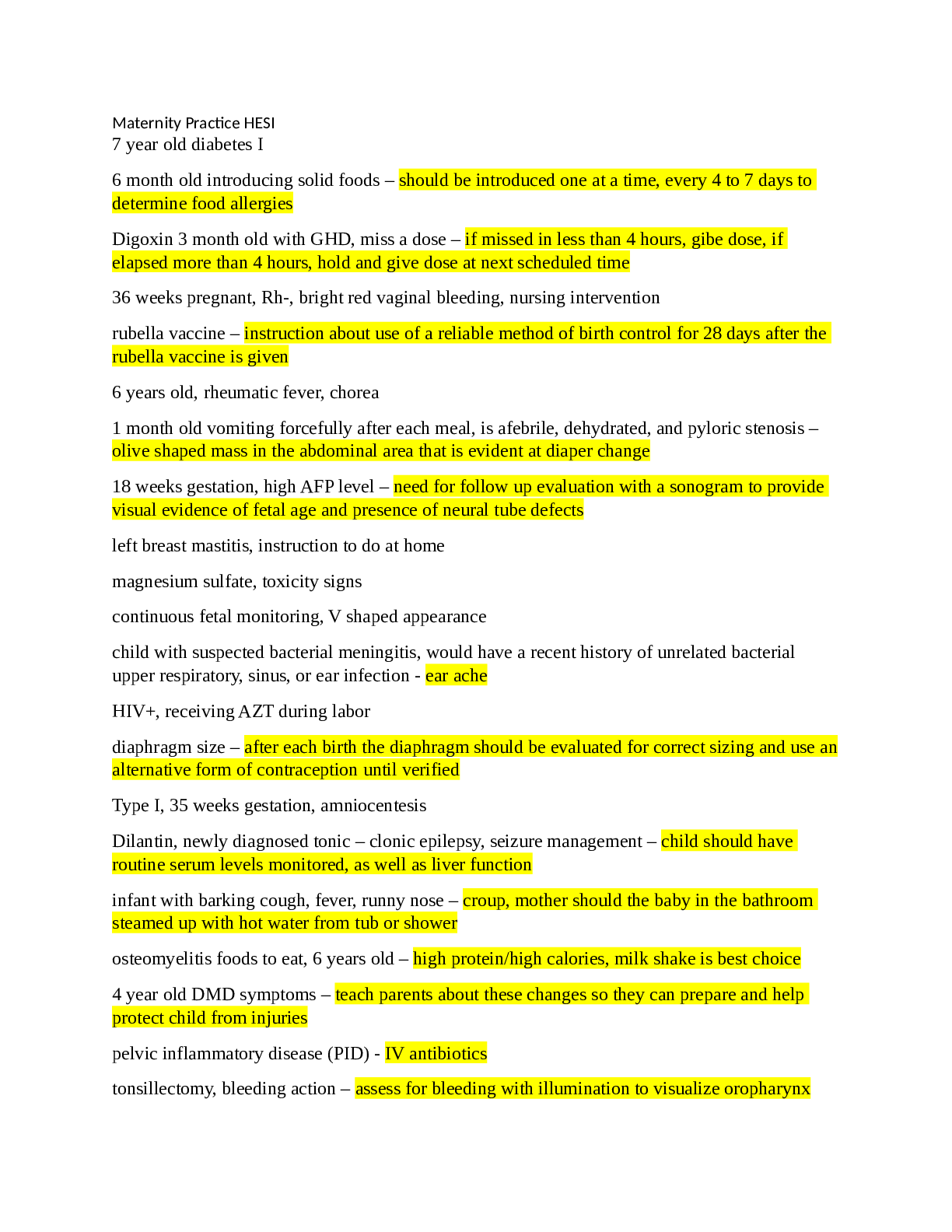
Reviews( 0 )
Document information
Connected school, study & course
About the document
Uploaded On
Sep 29, 2021
Number of pages
50
Written in
Additional information
This document has been written for:
Uploaded
Sep 29, 2021
Downloads
0
Views
75


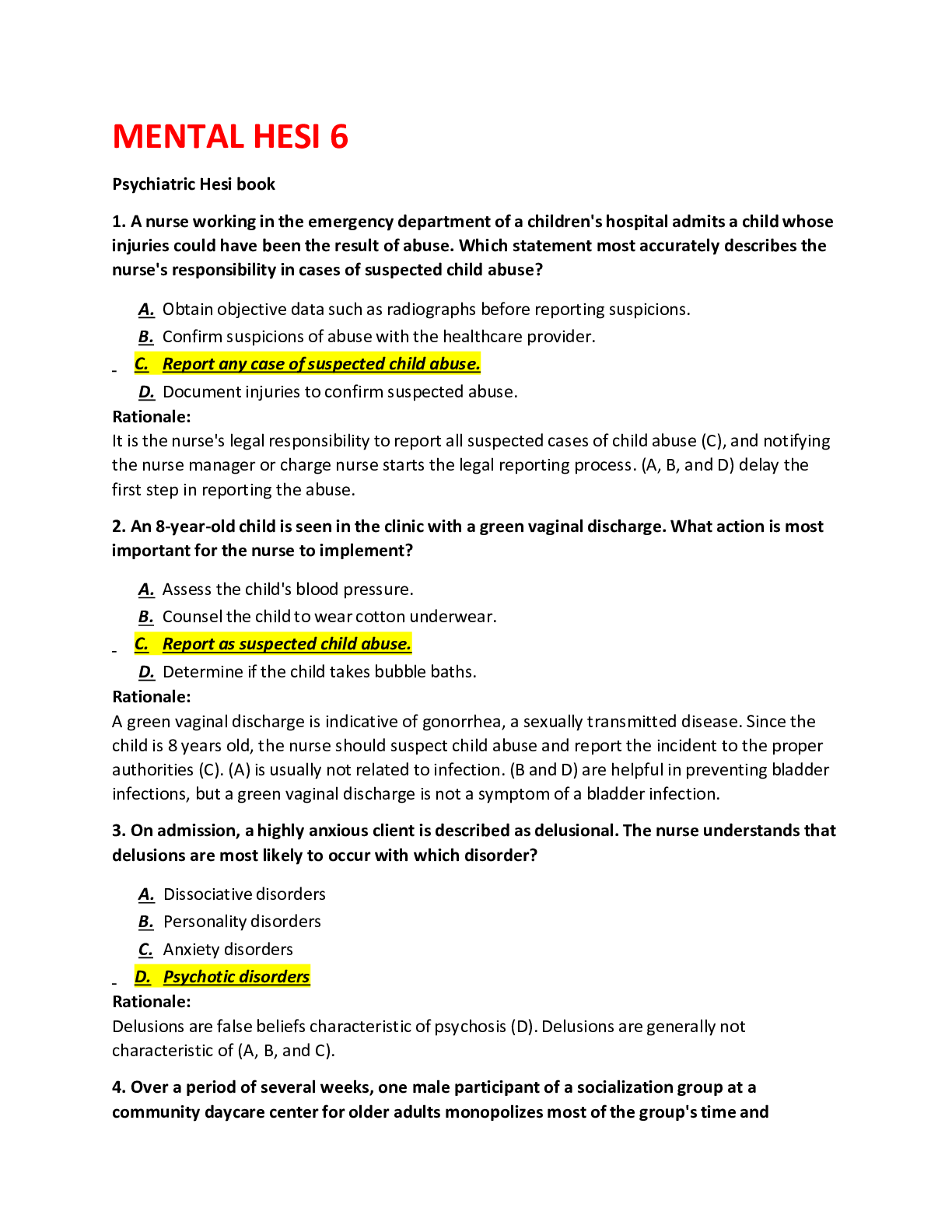
.png)


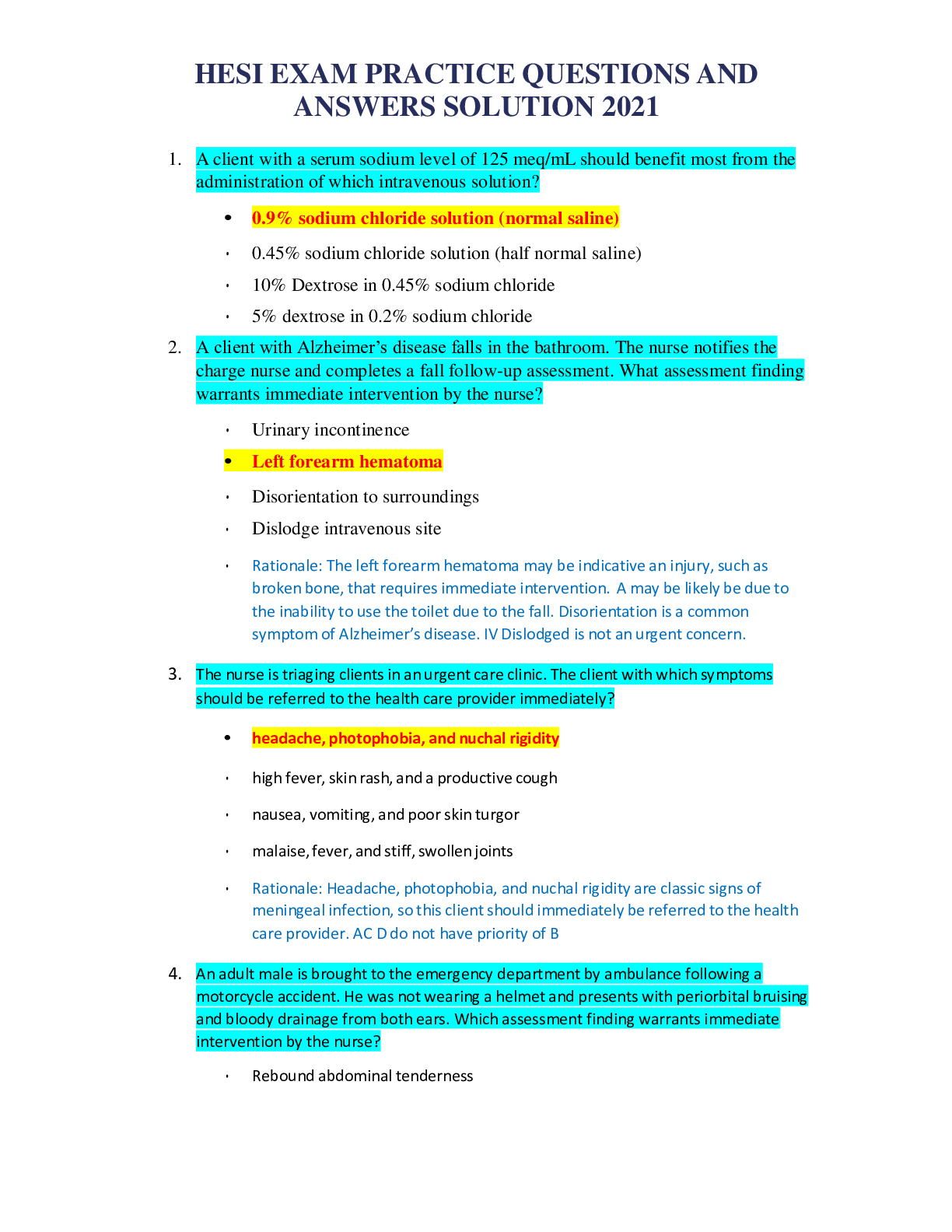
.png)
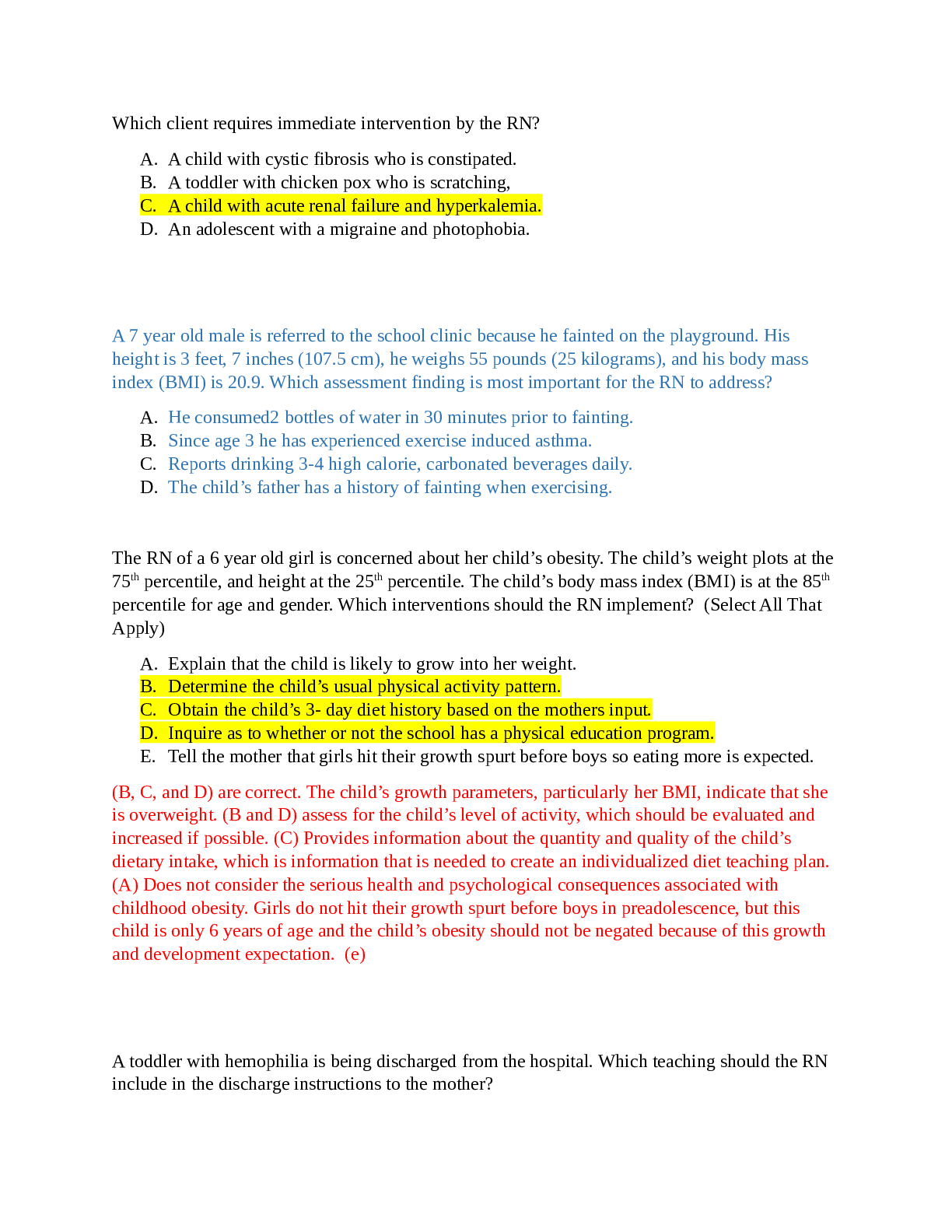



.png)
